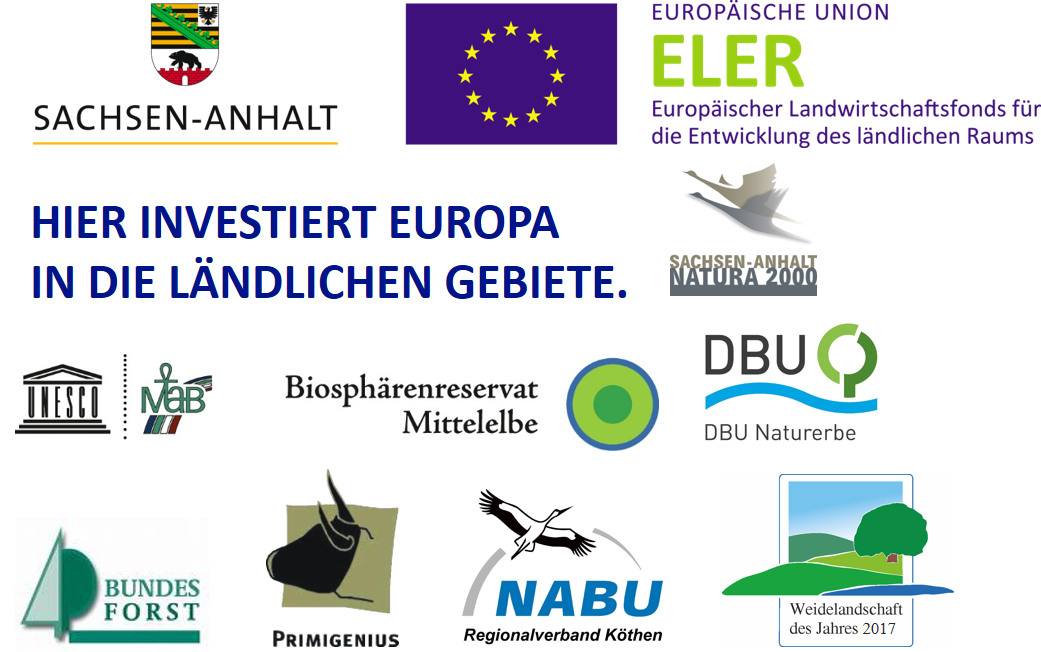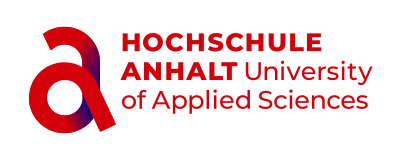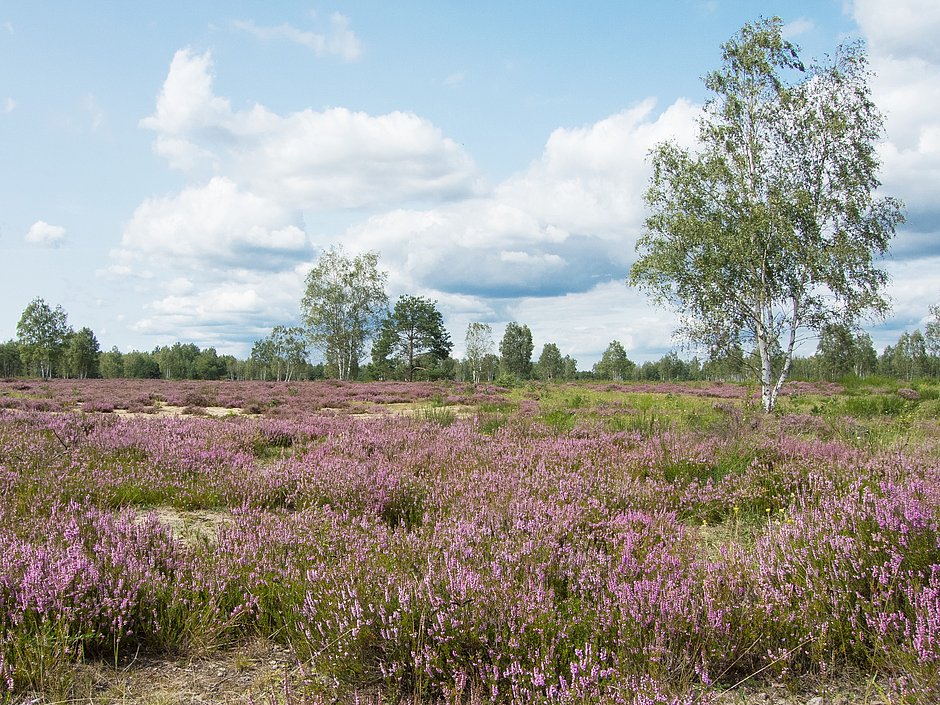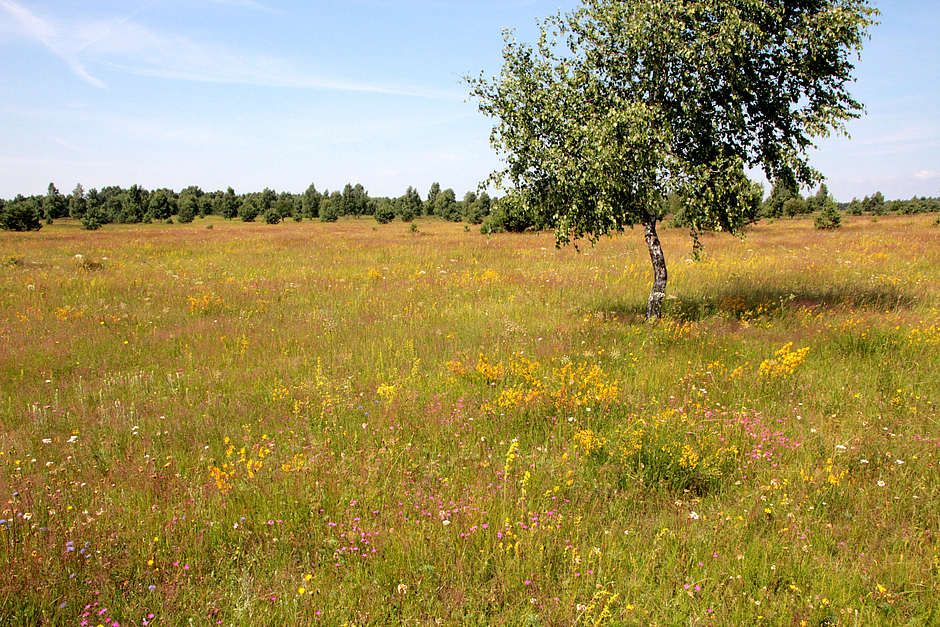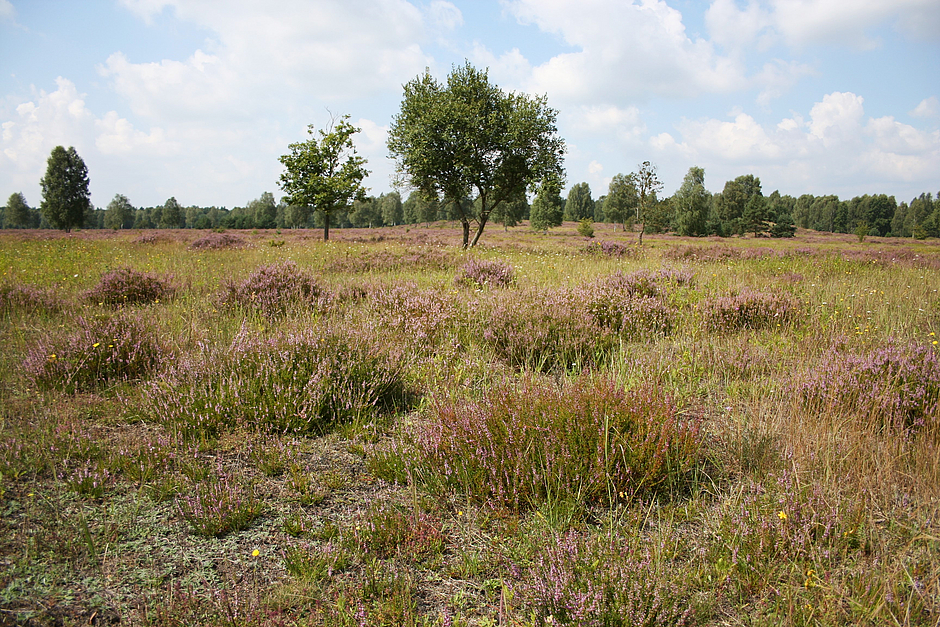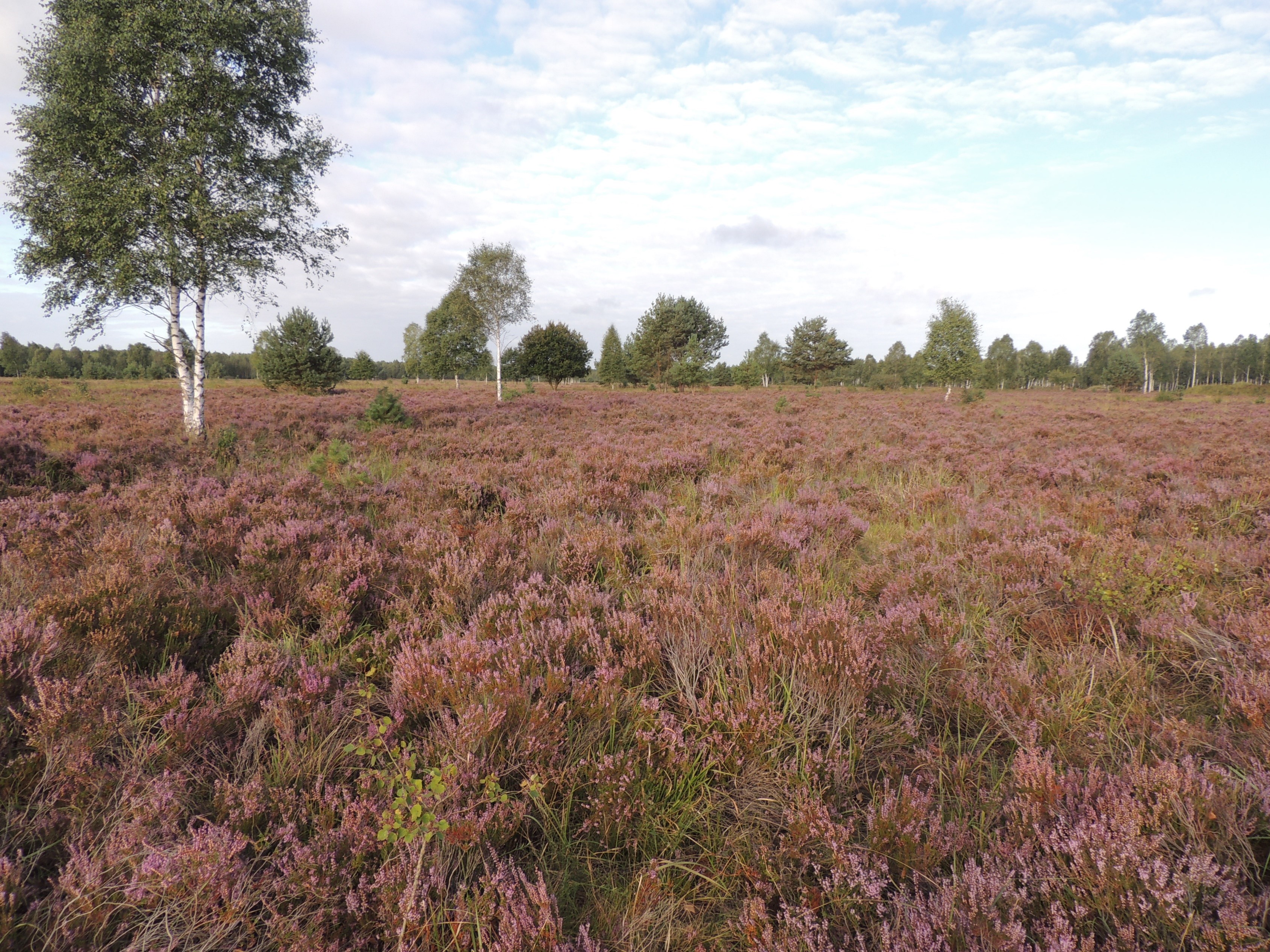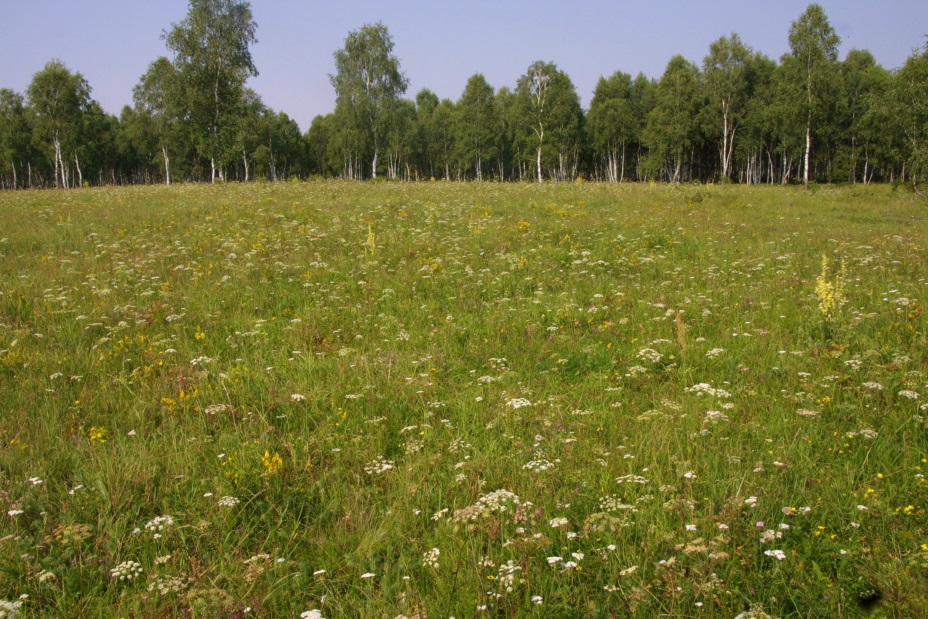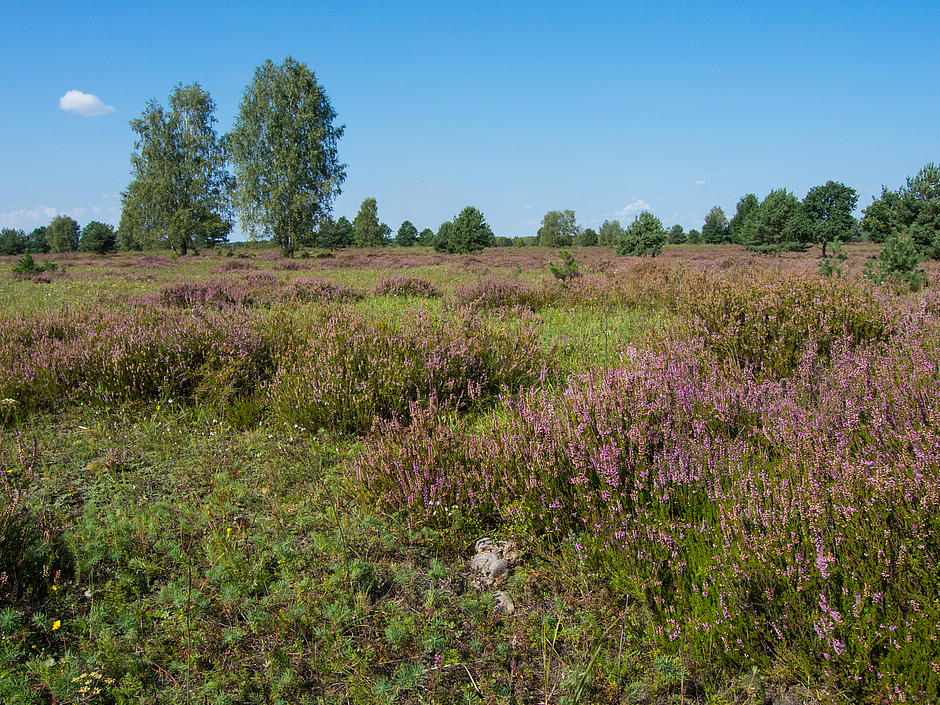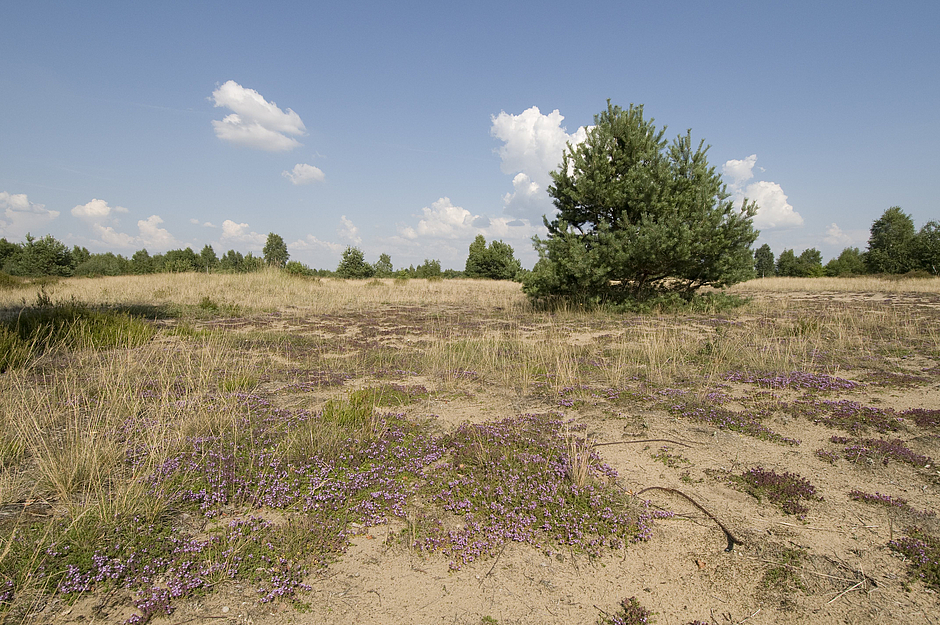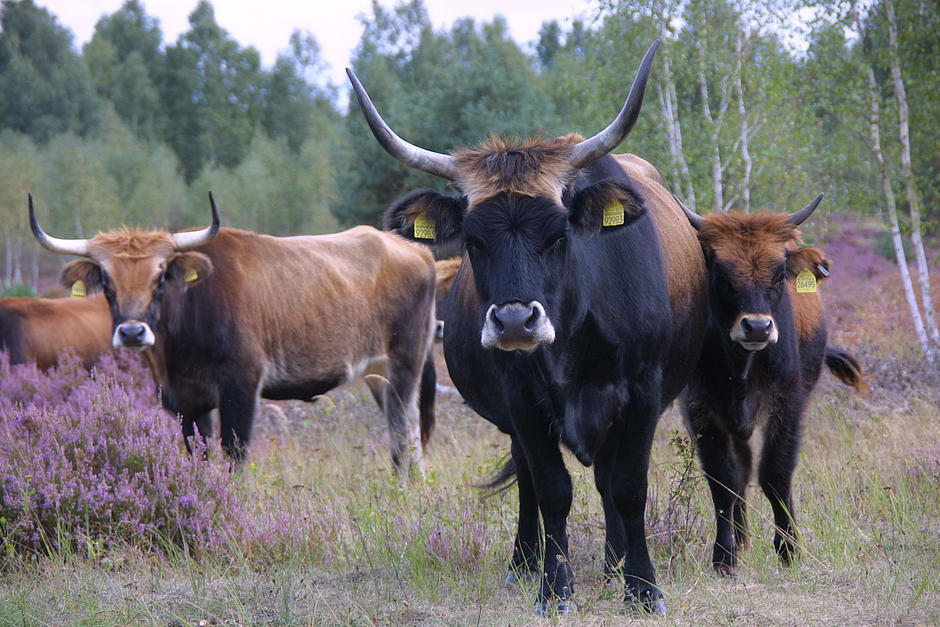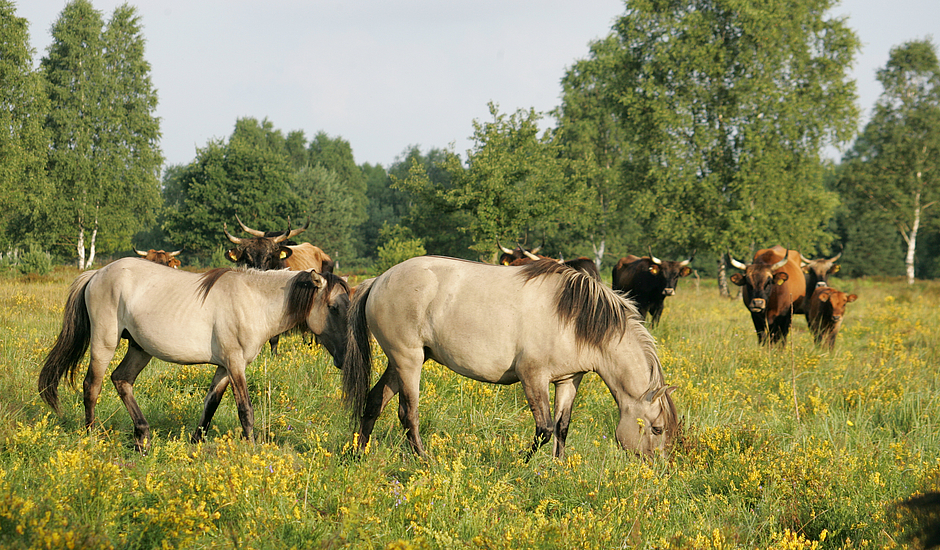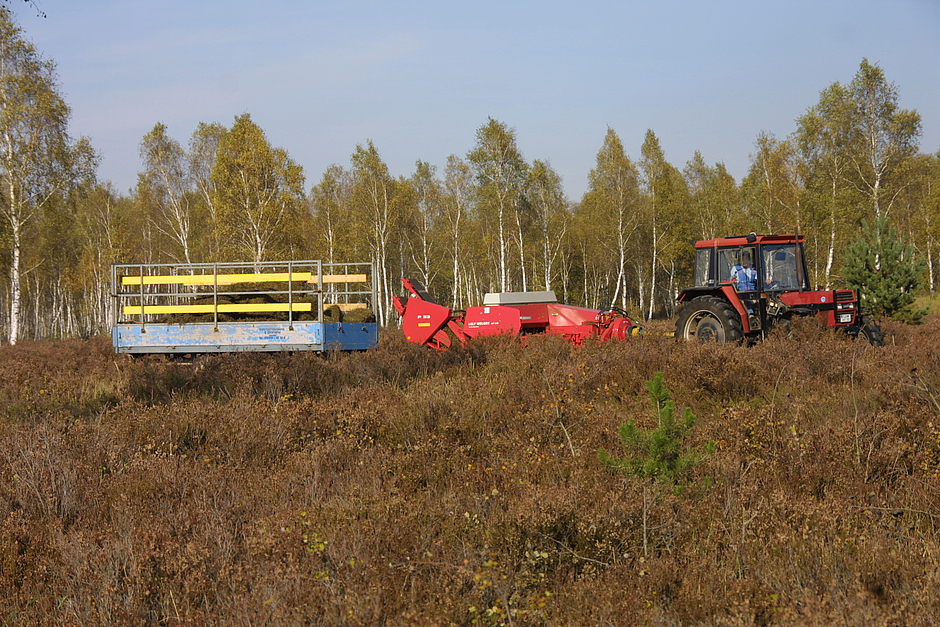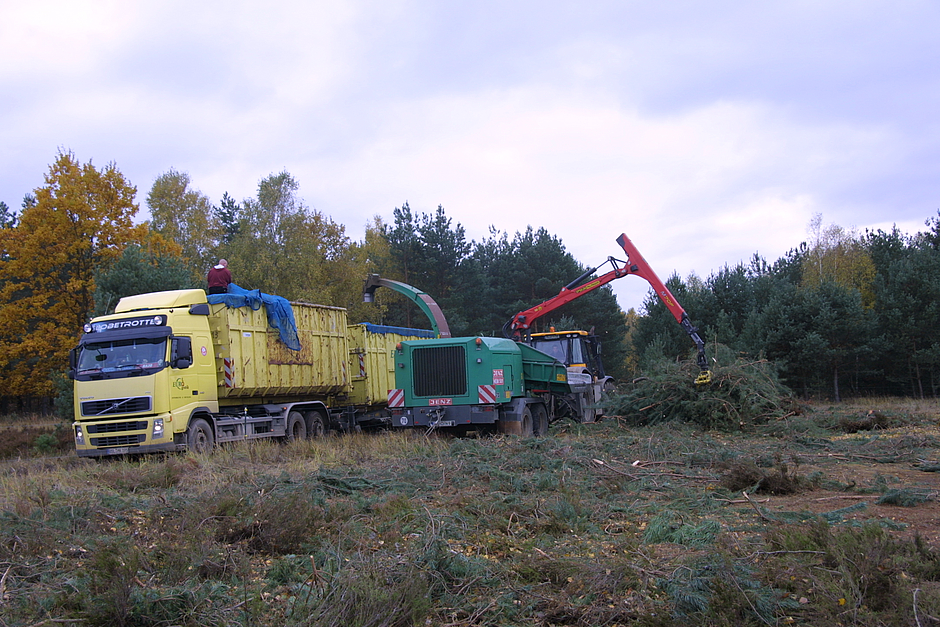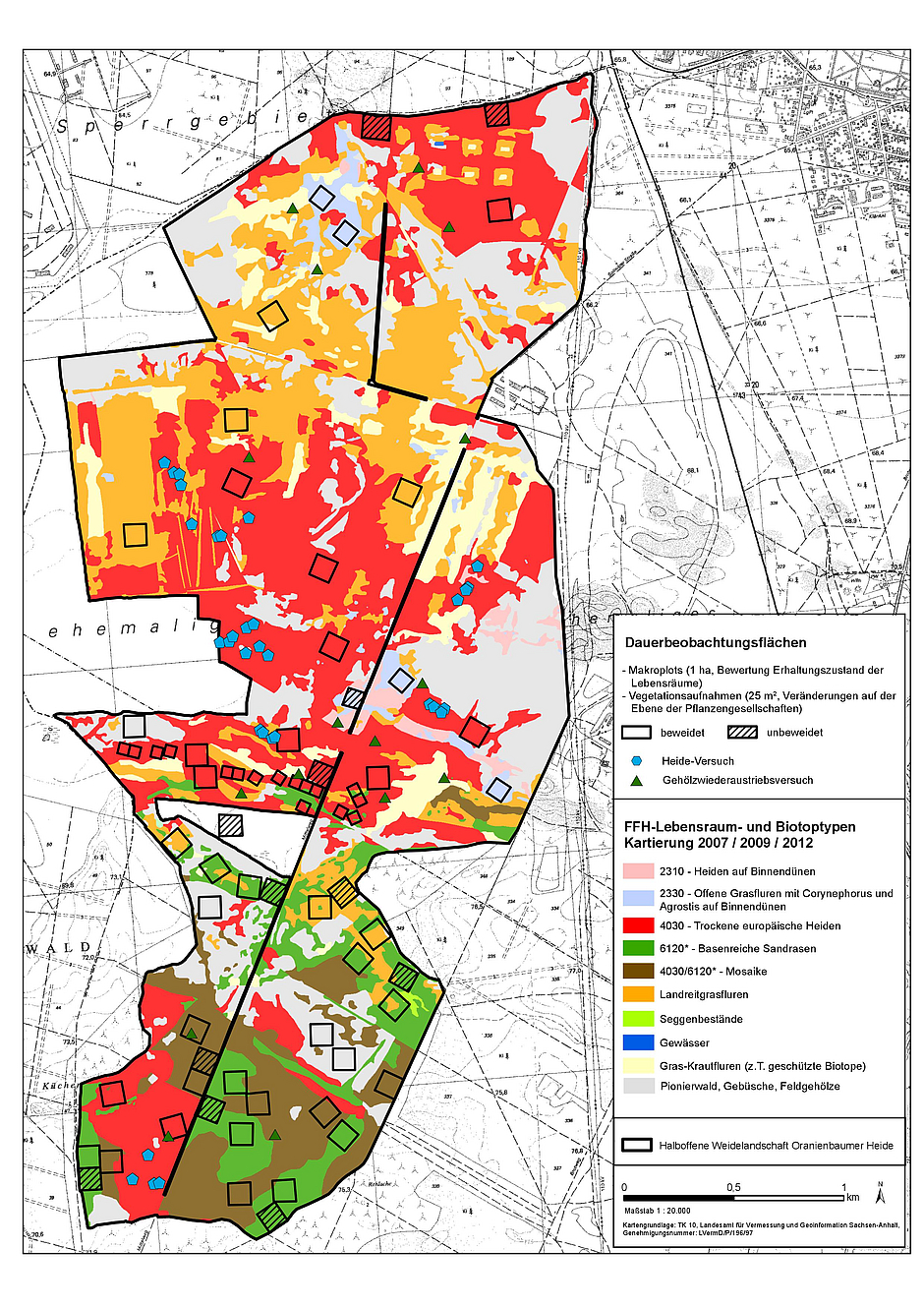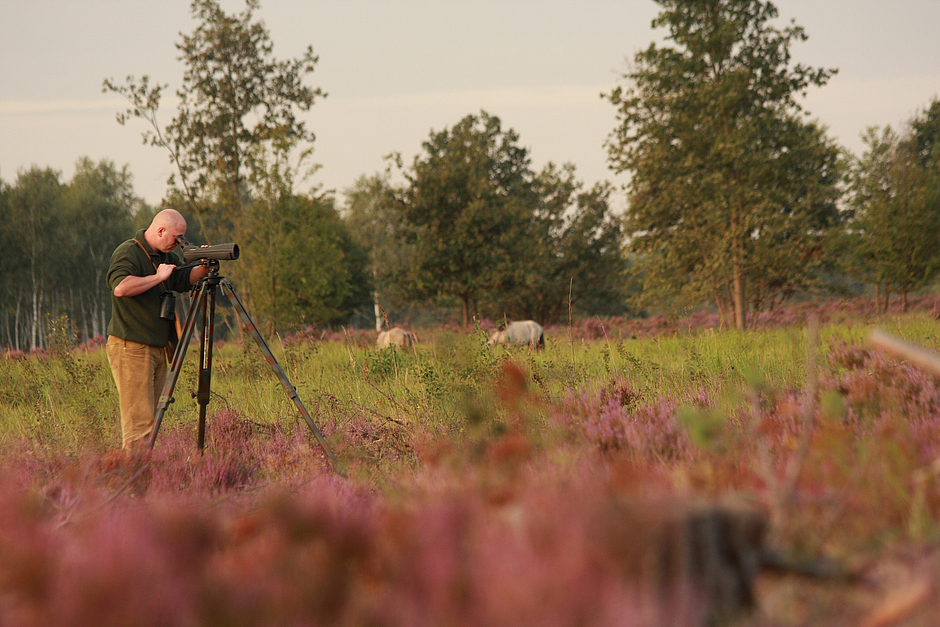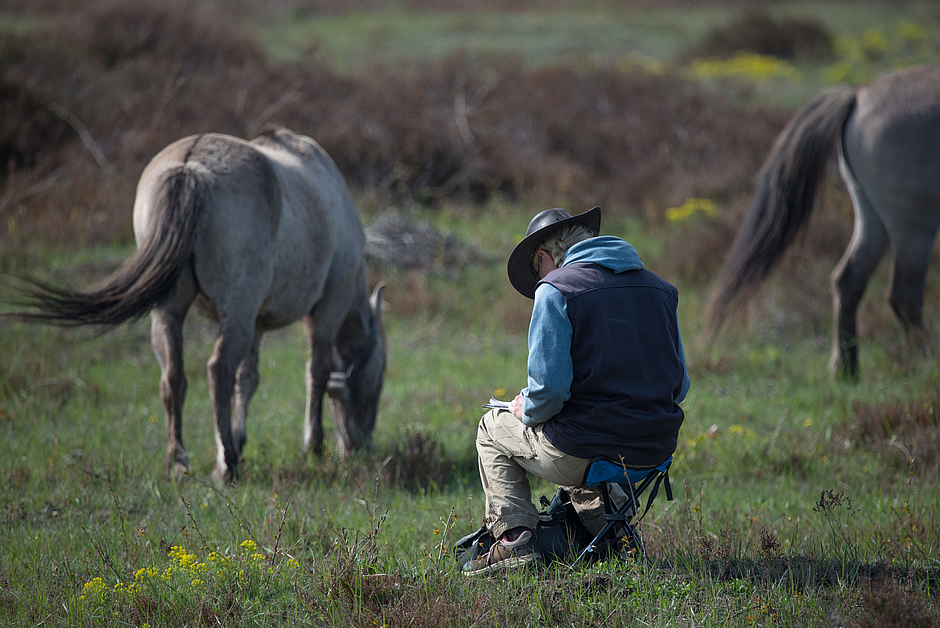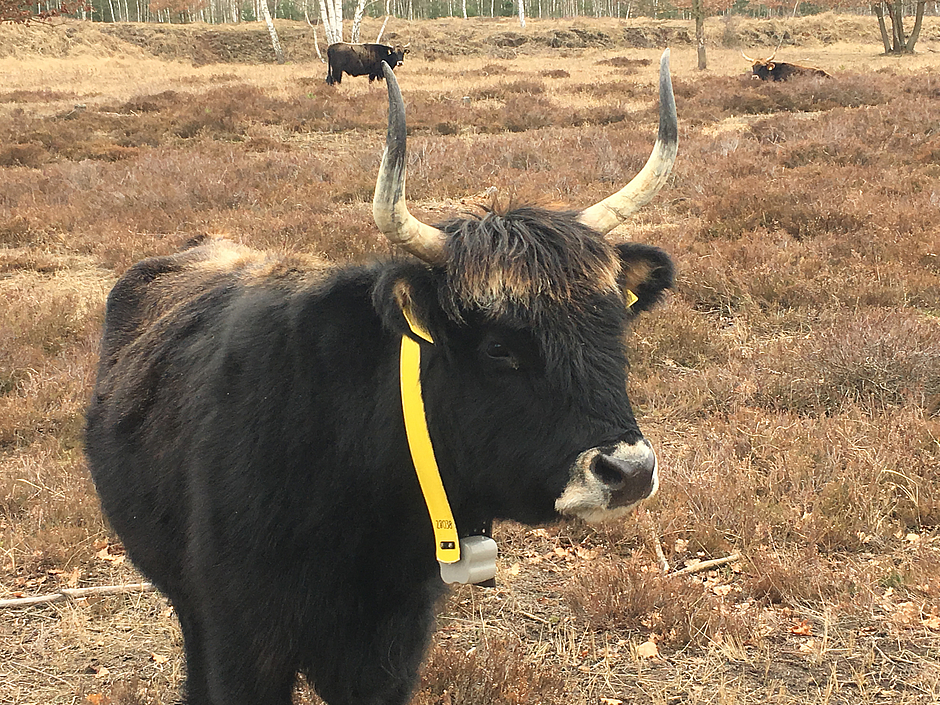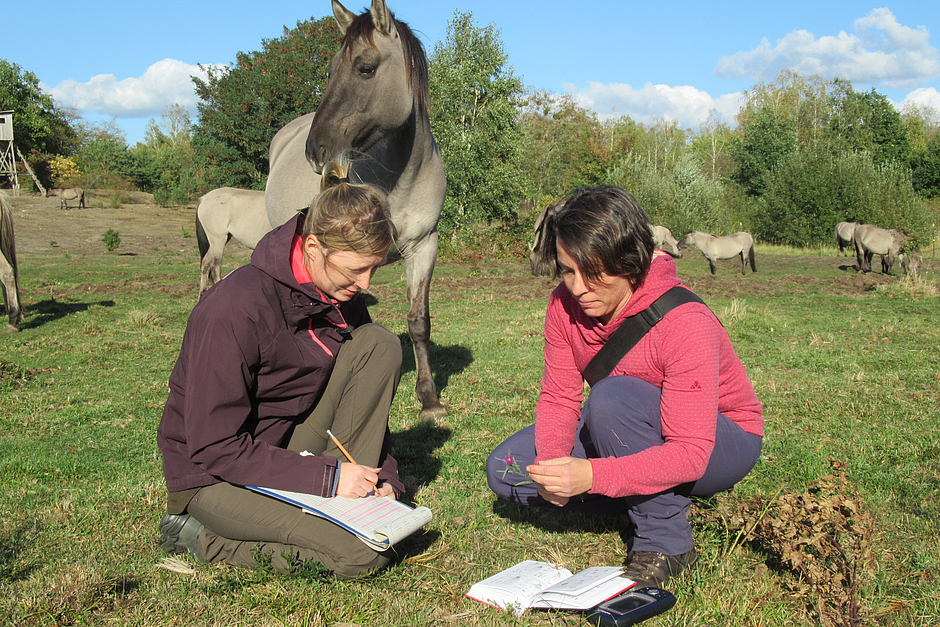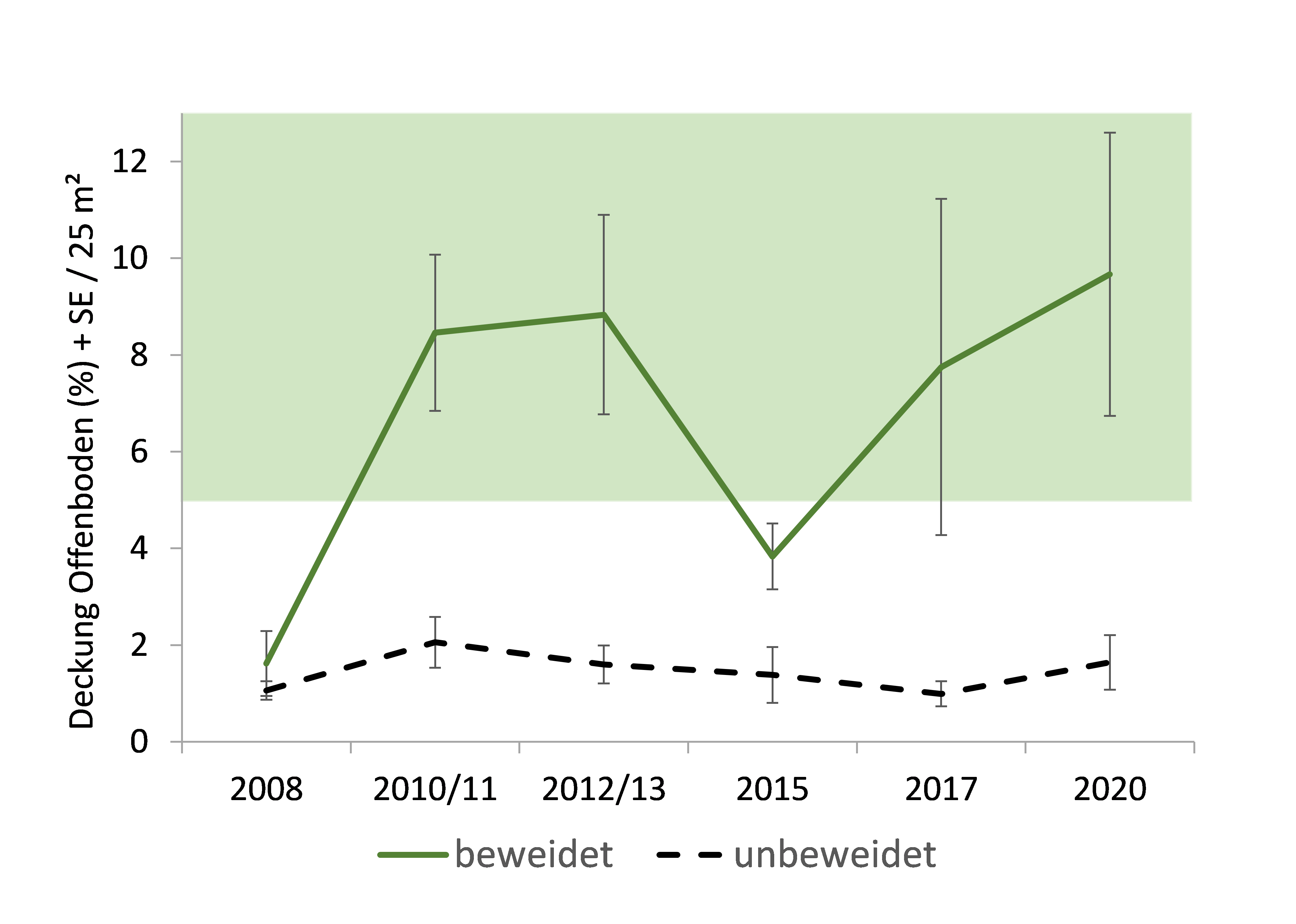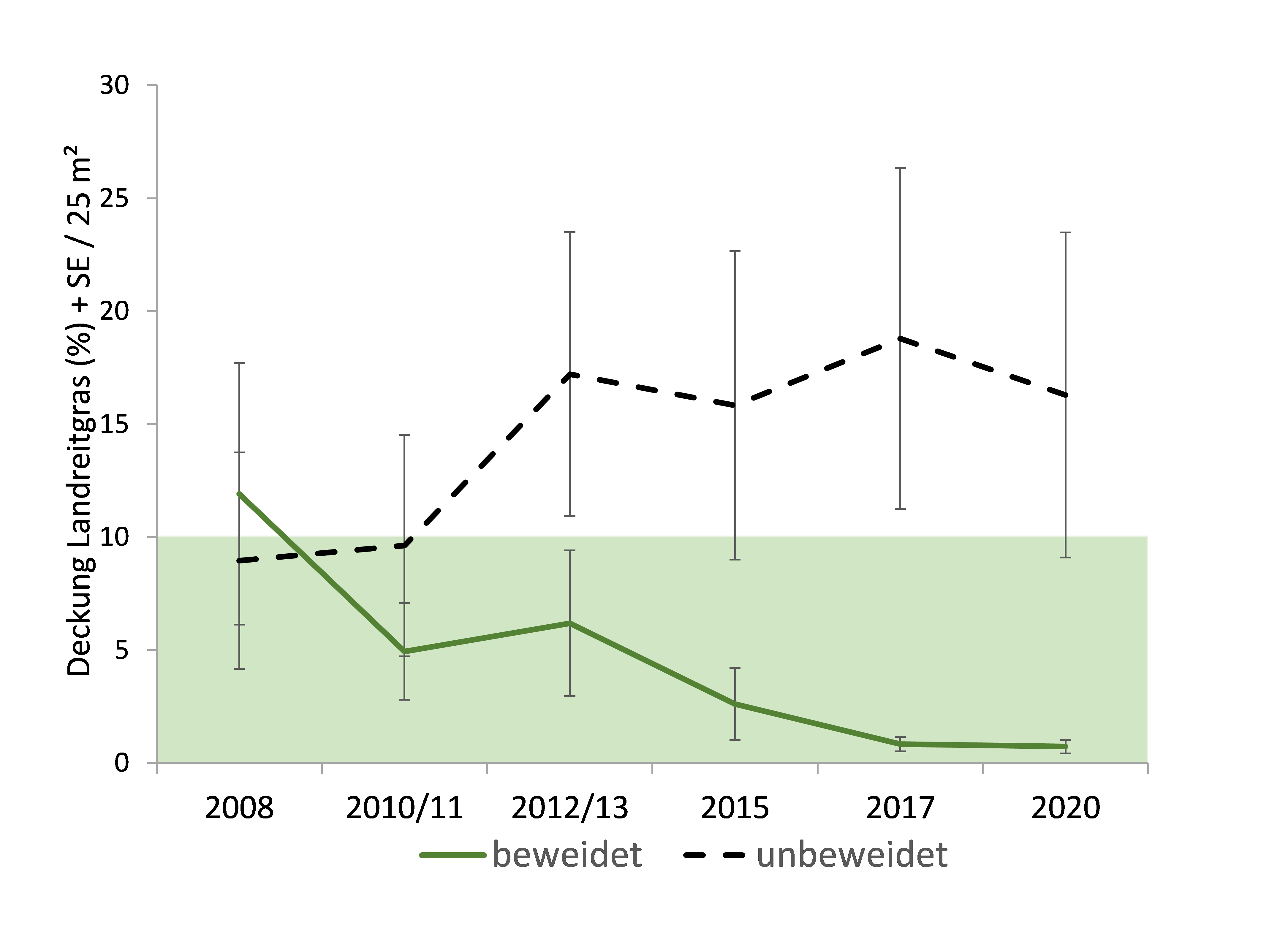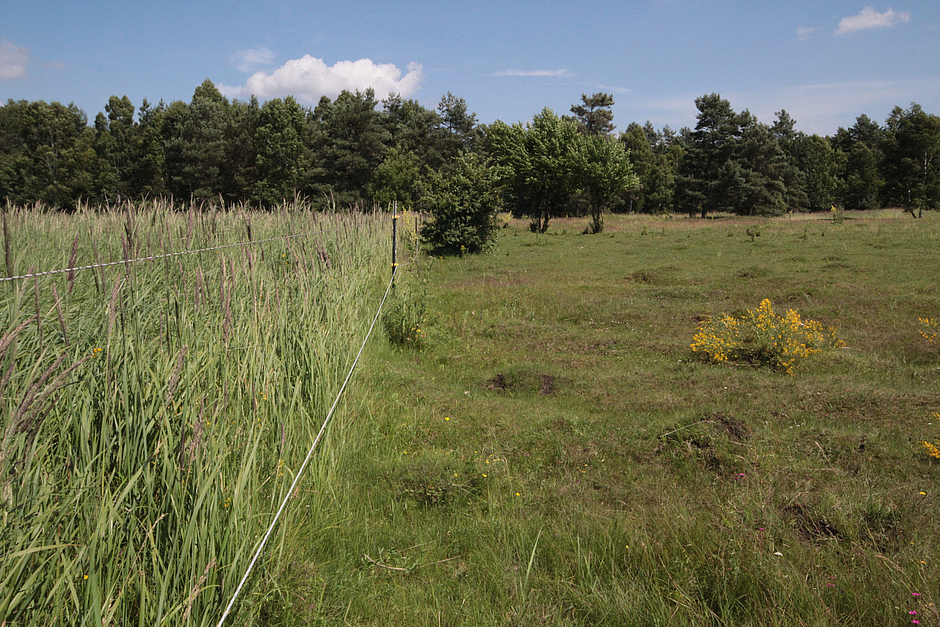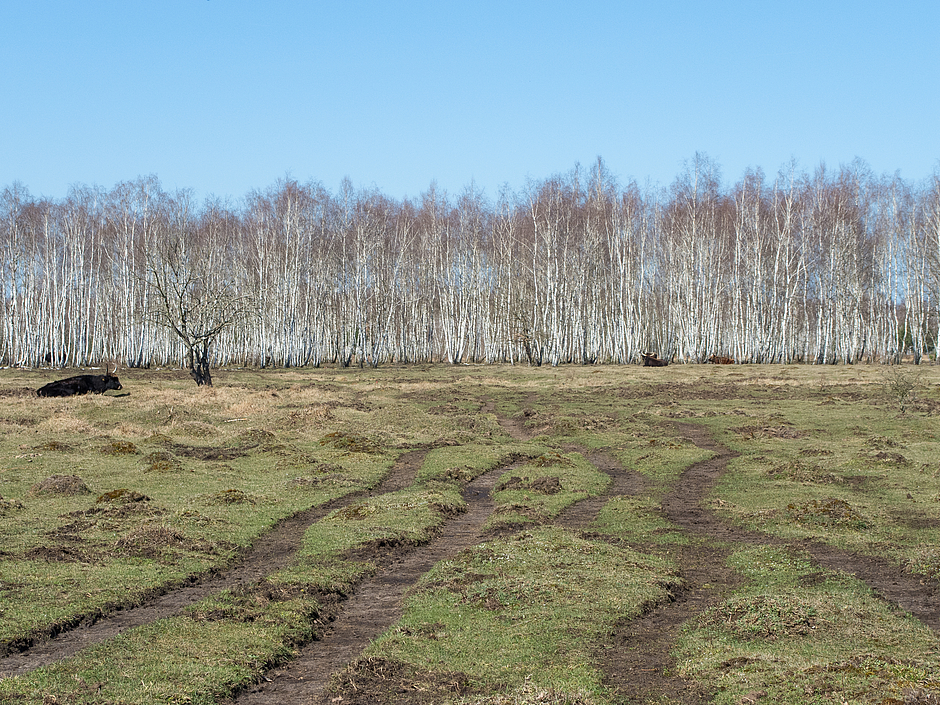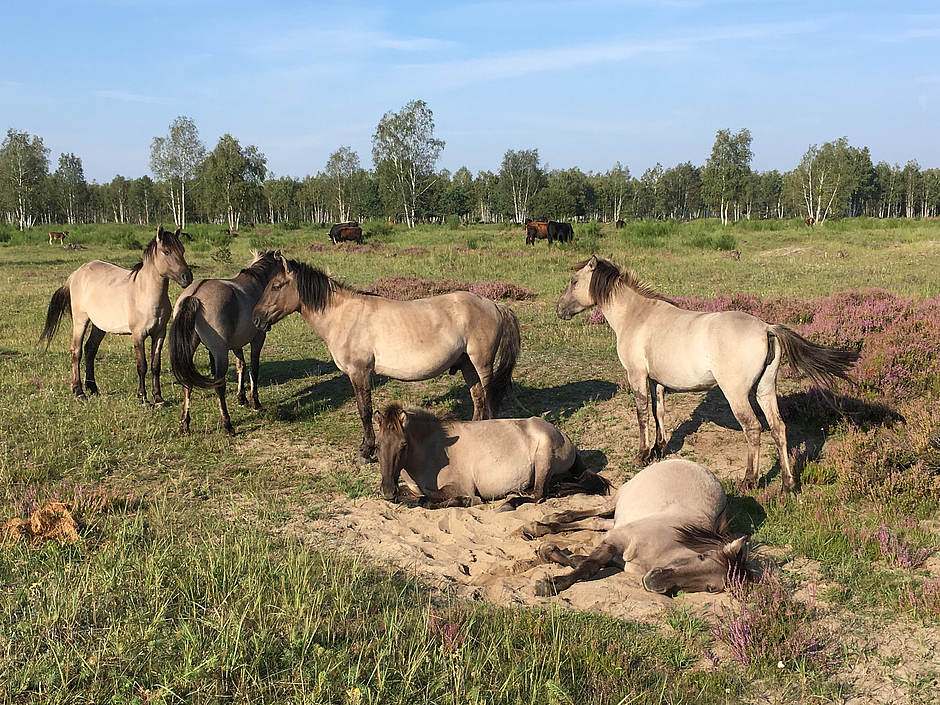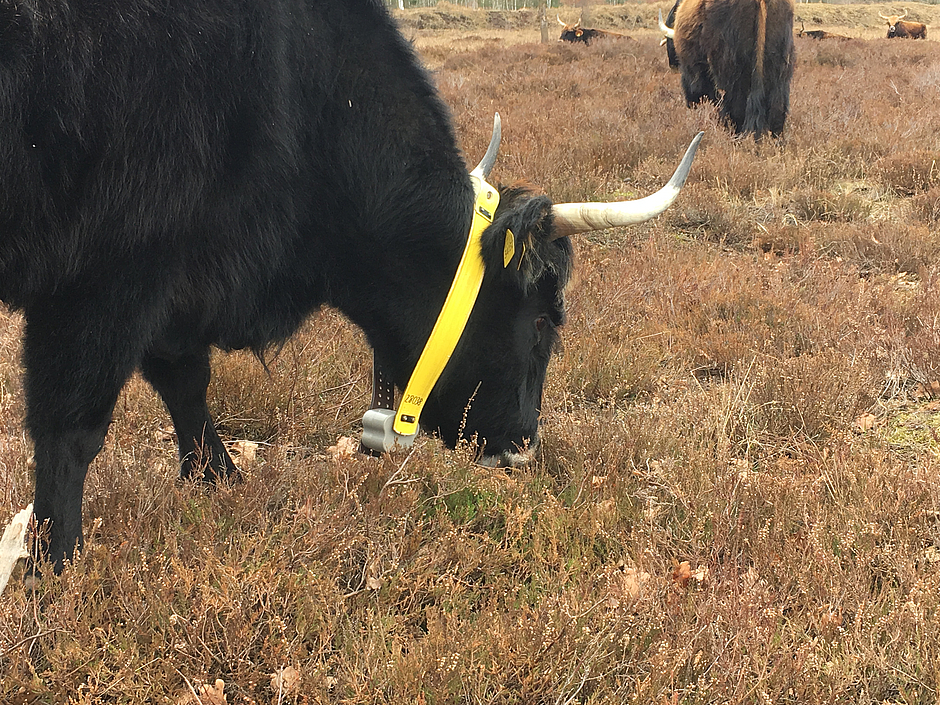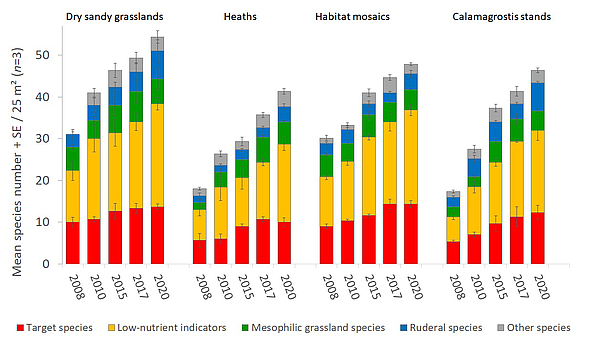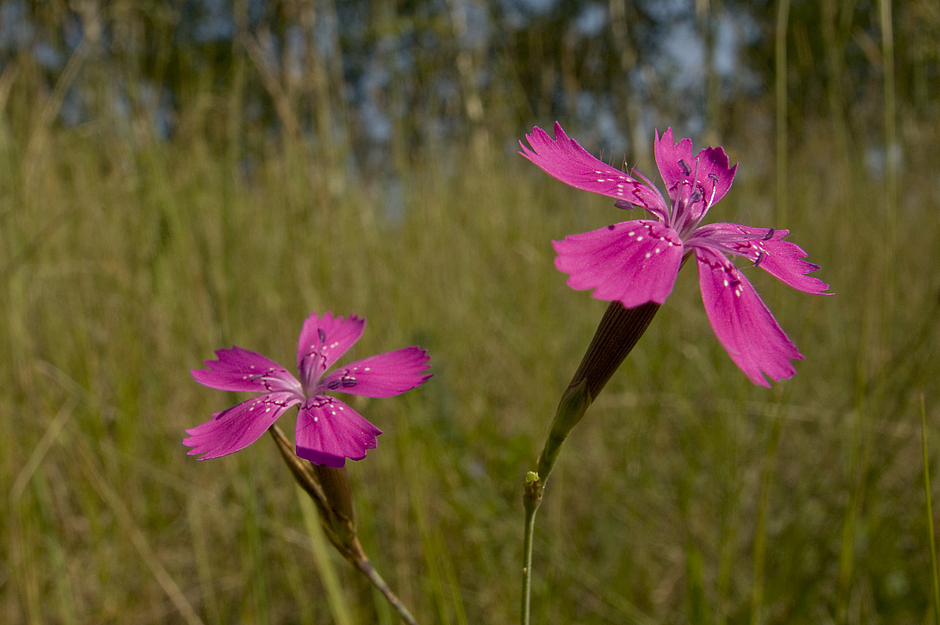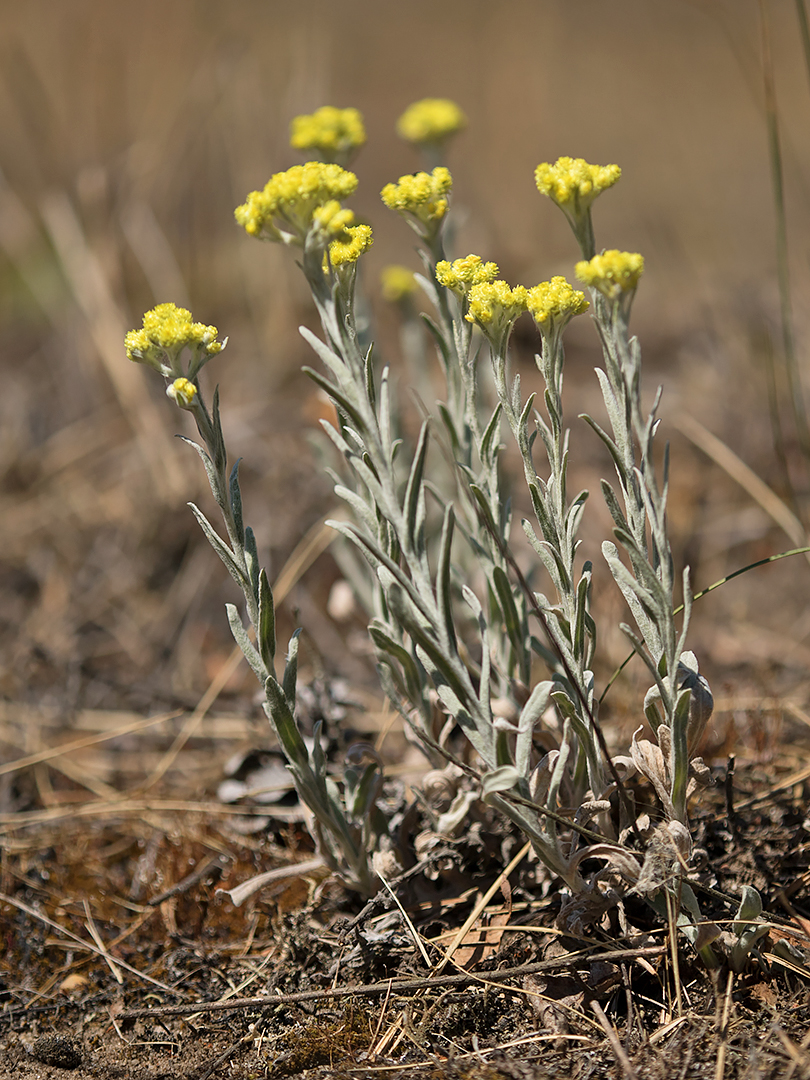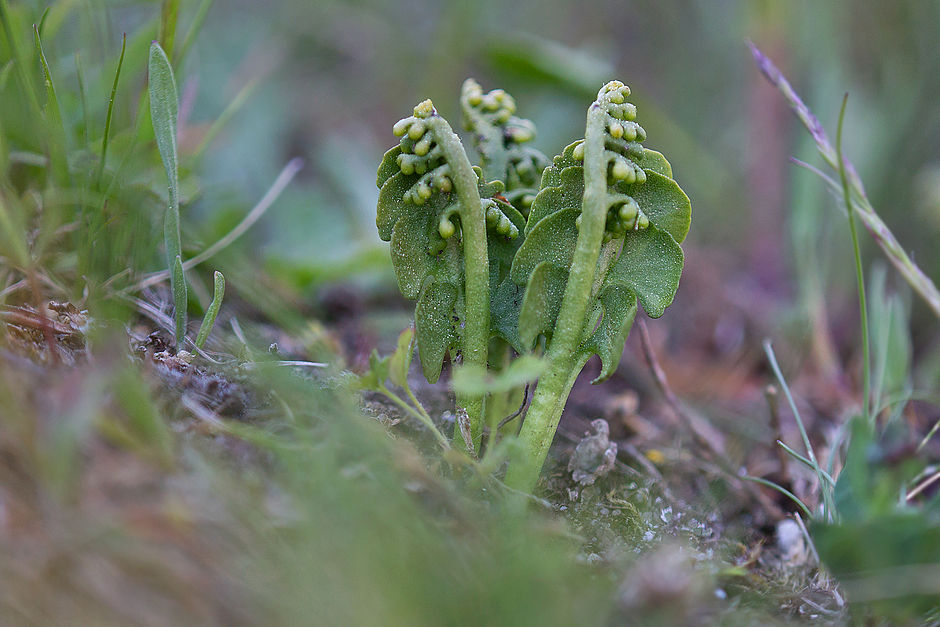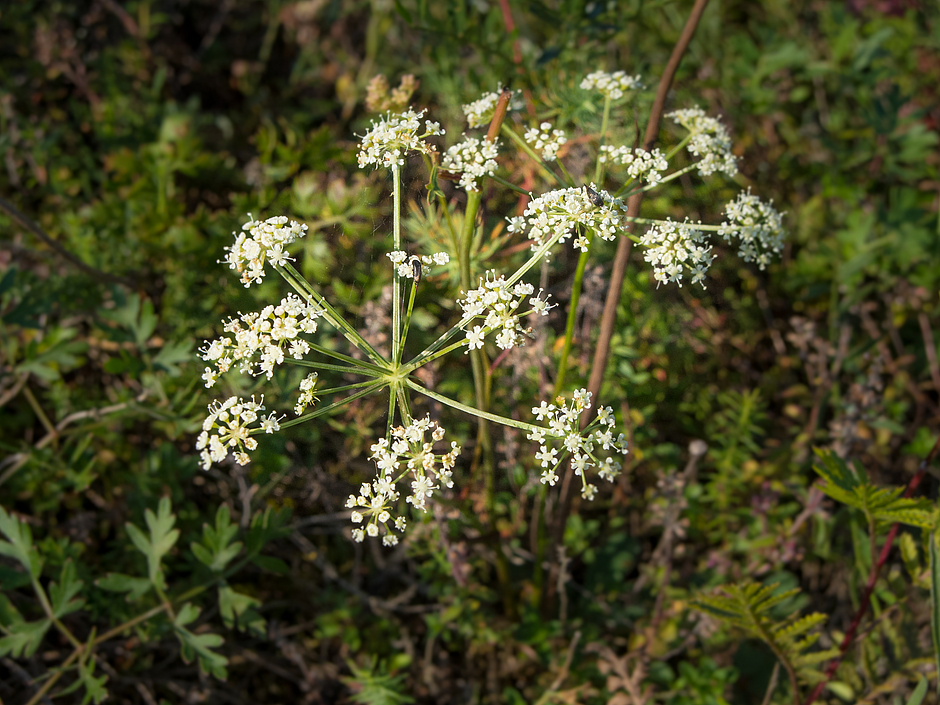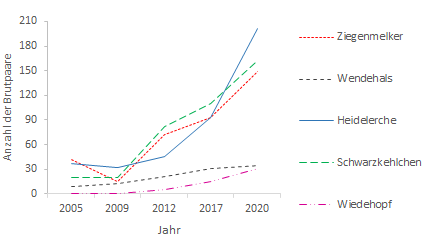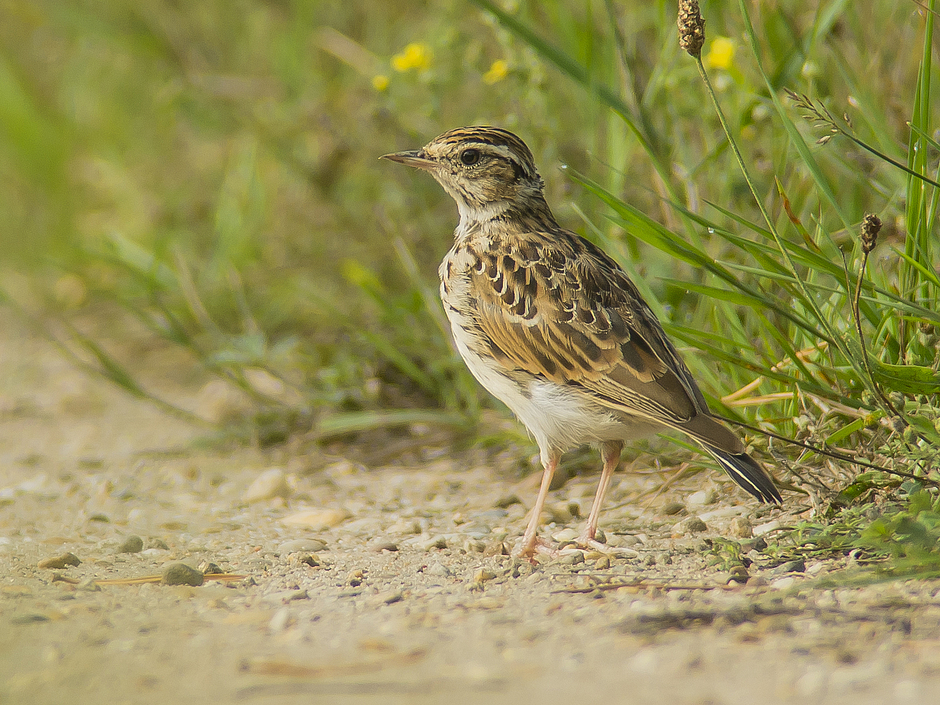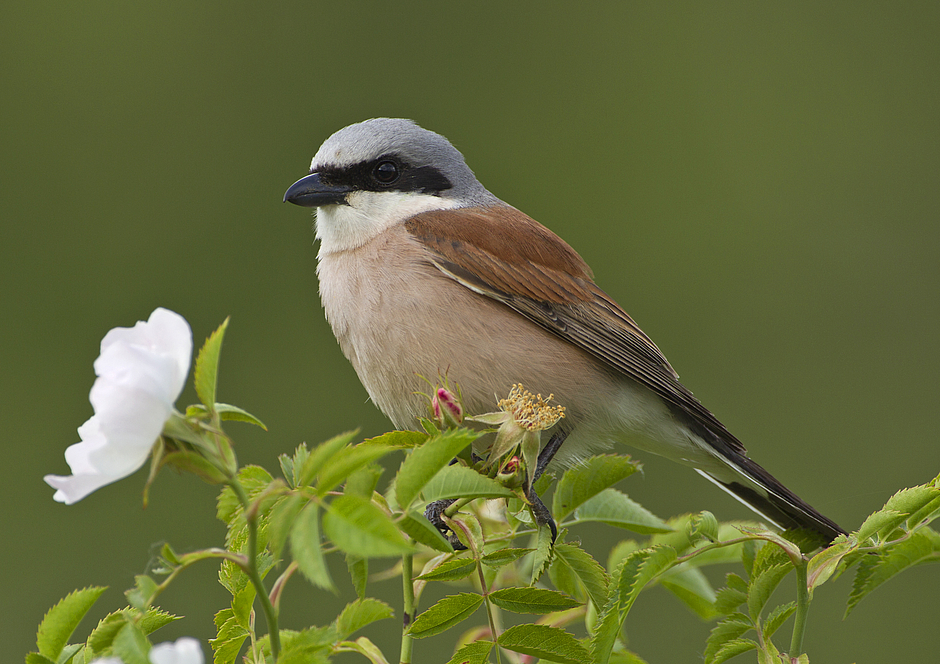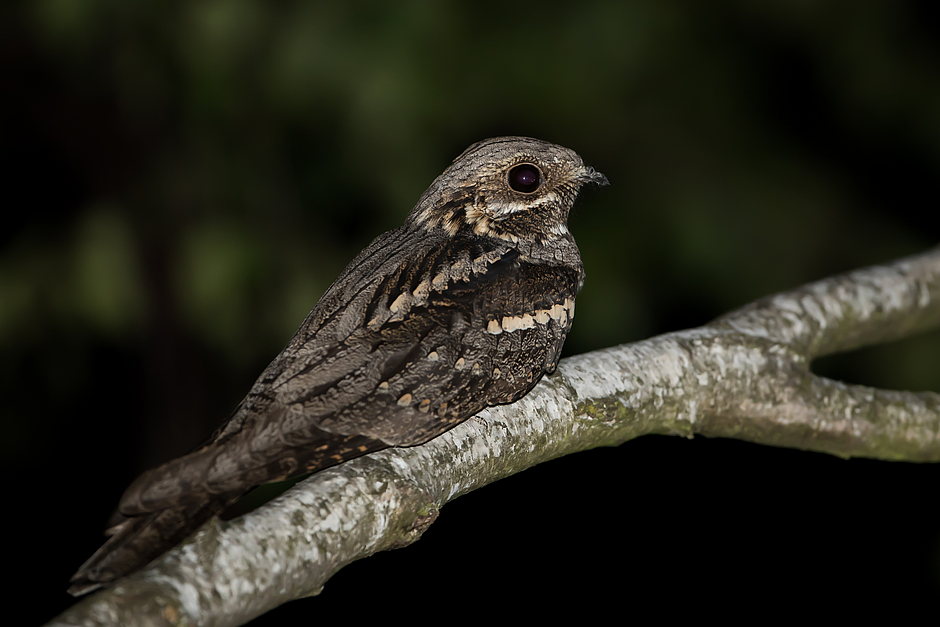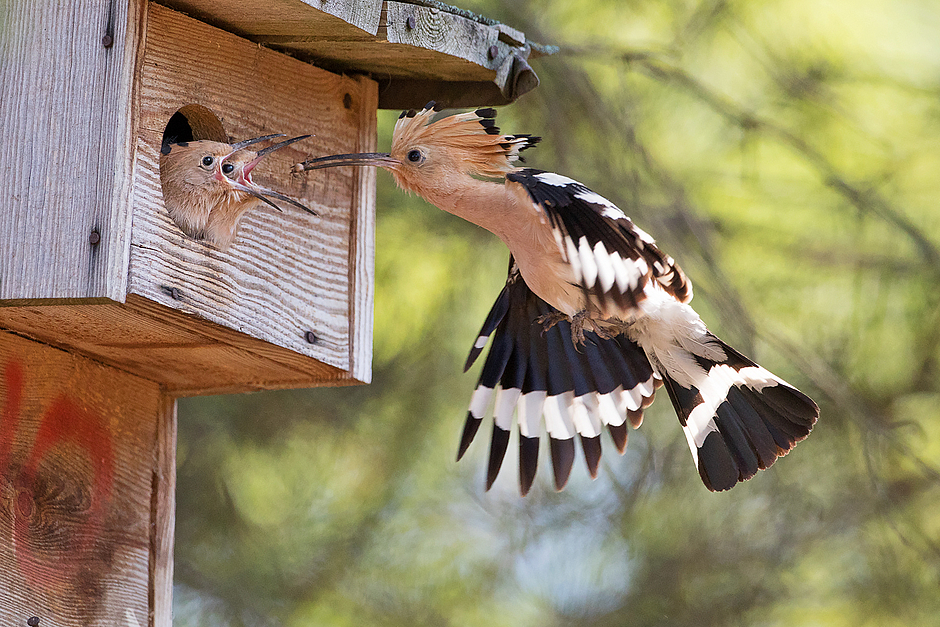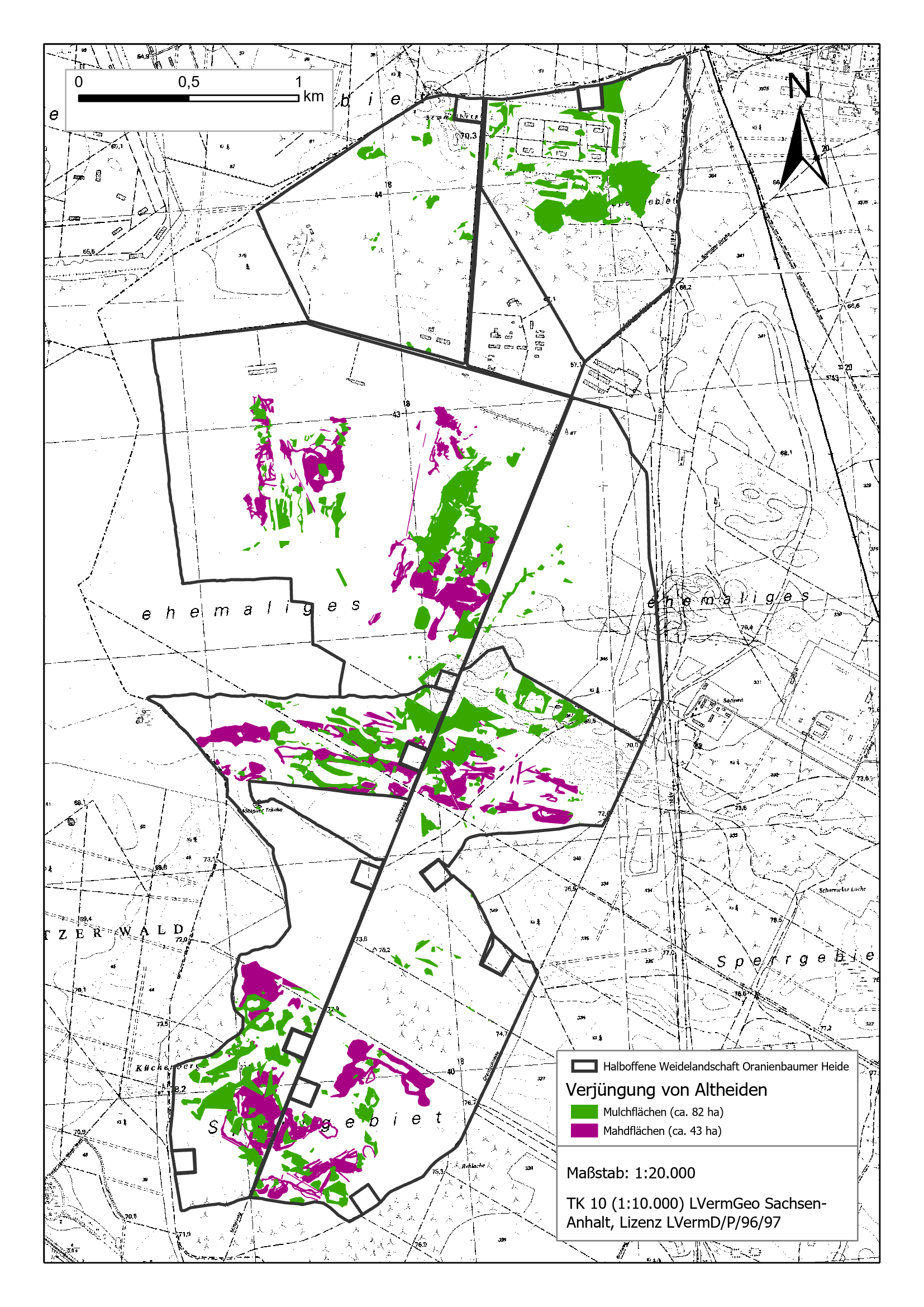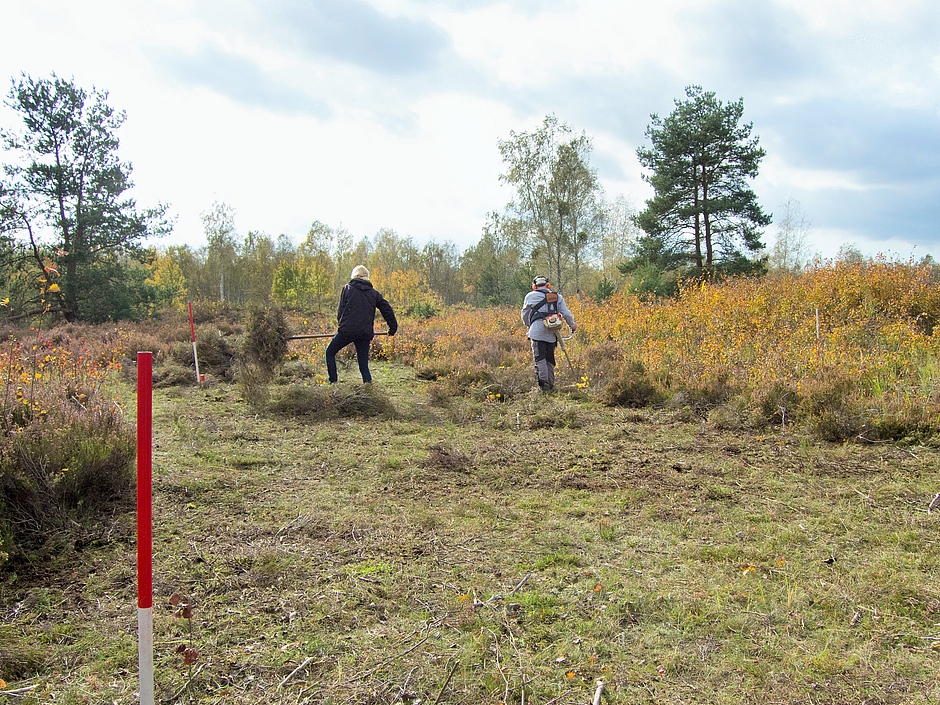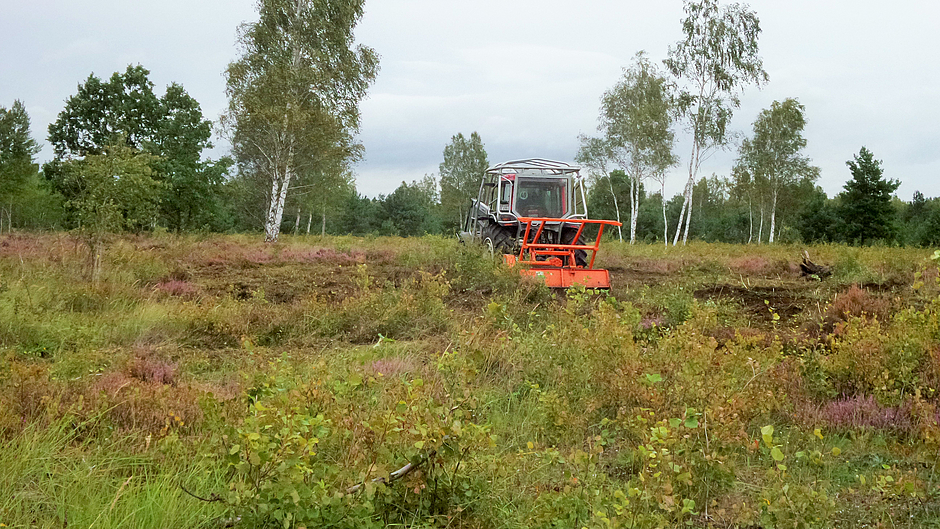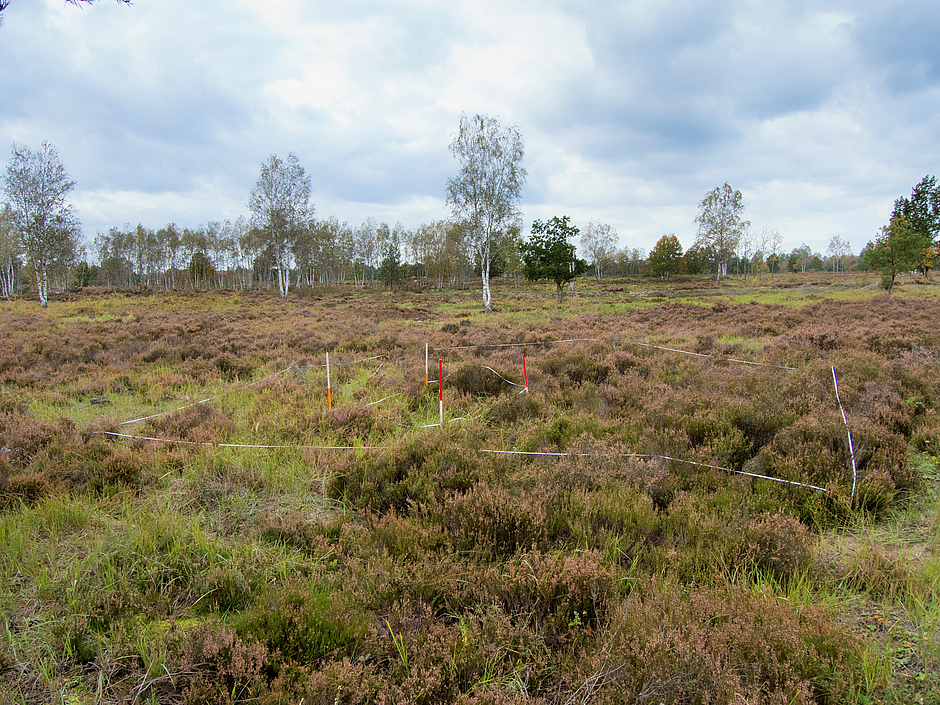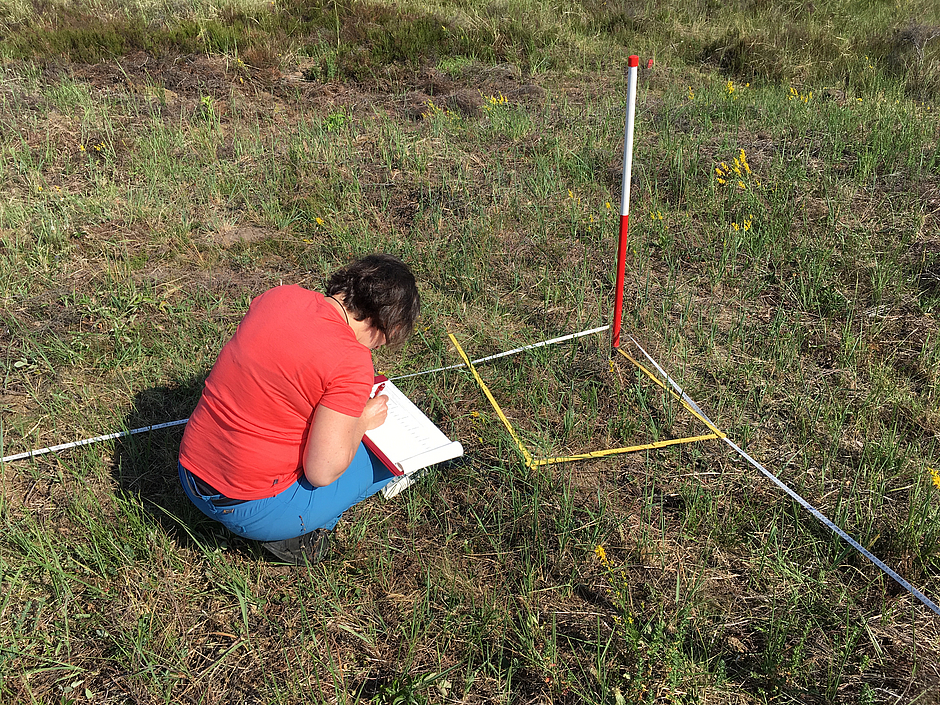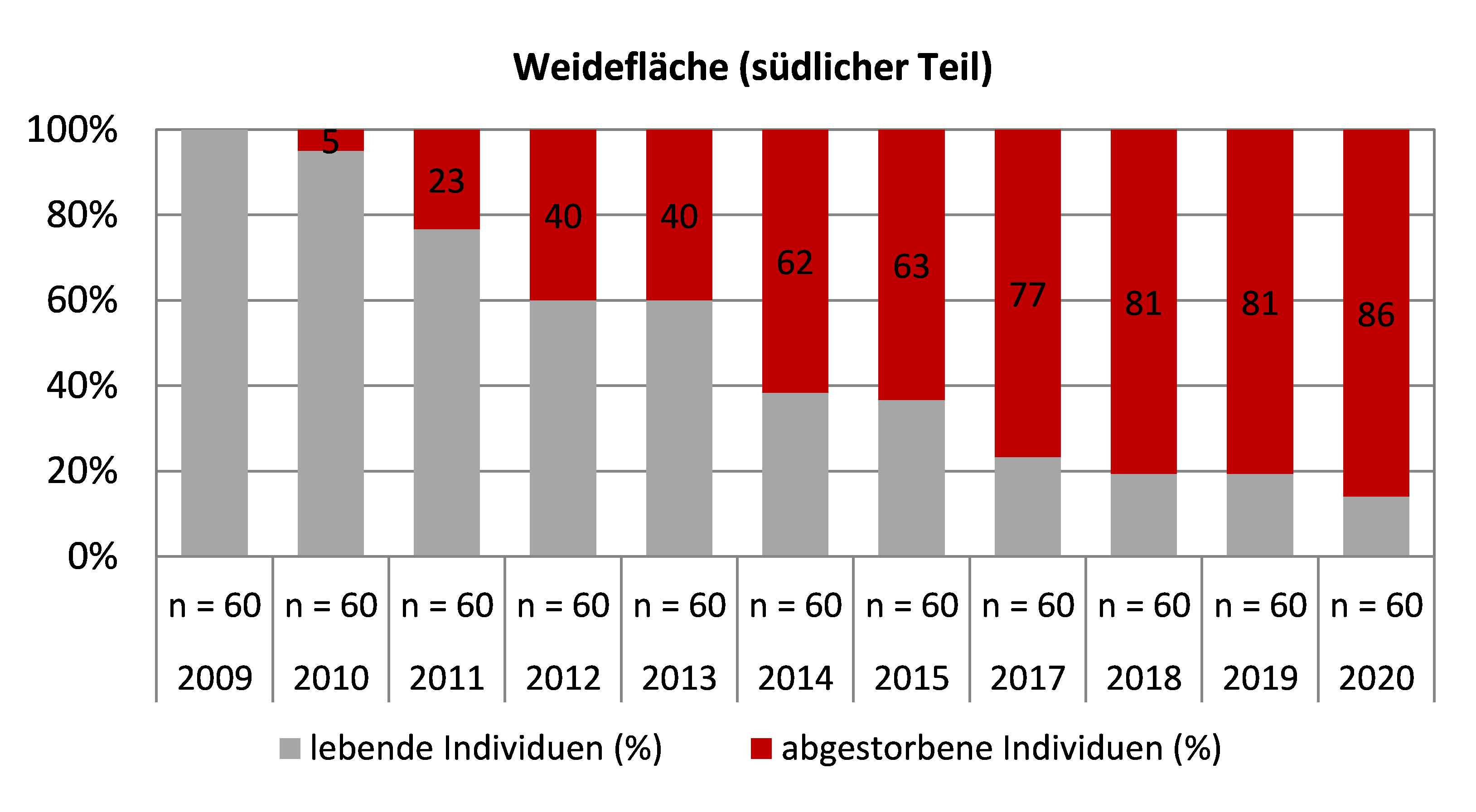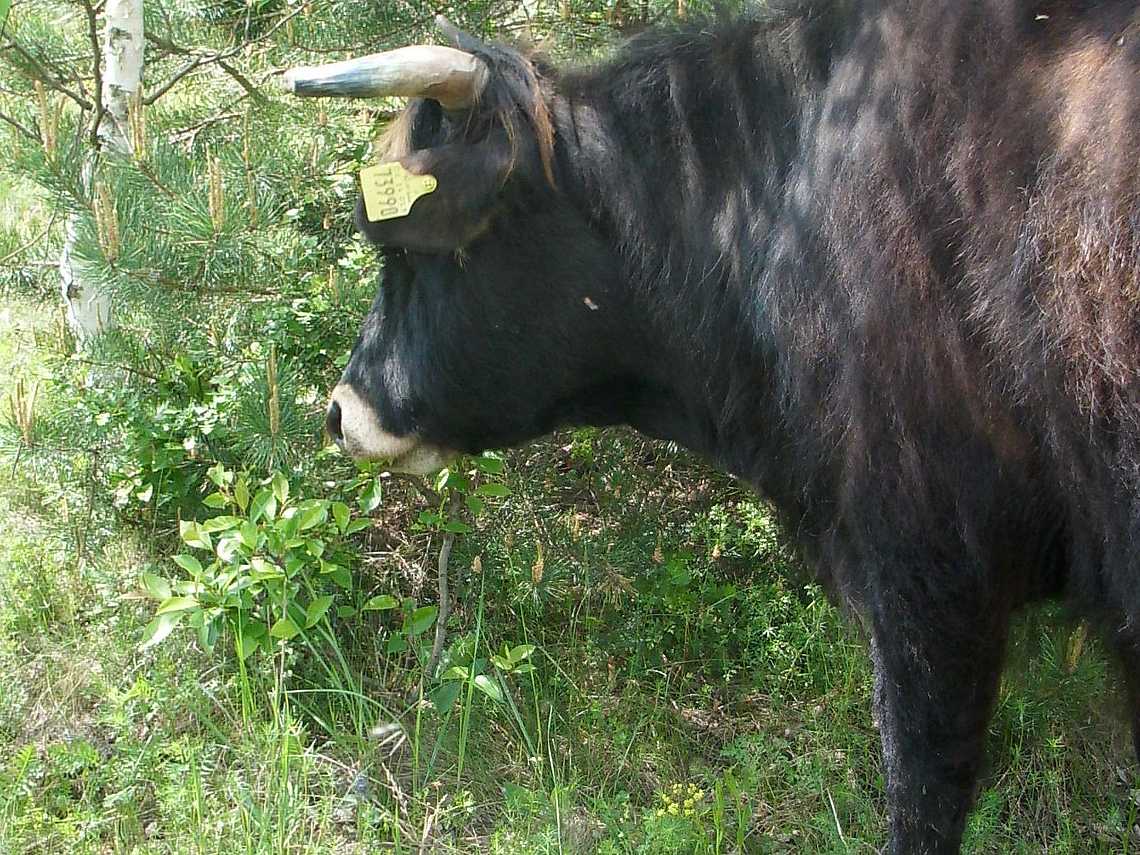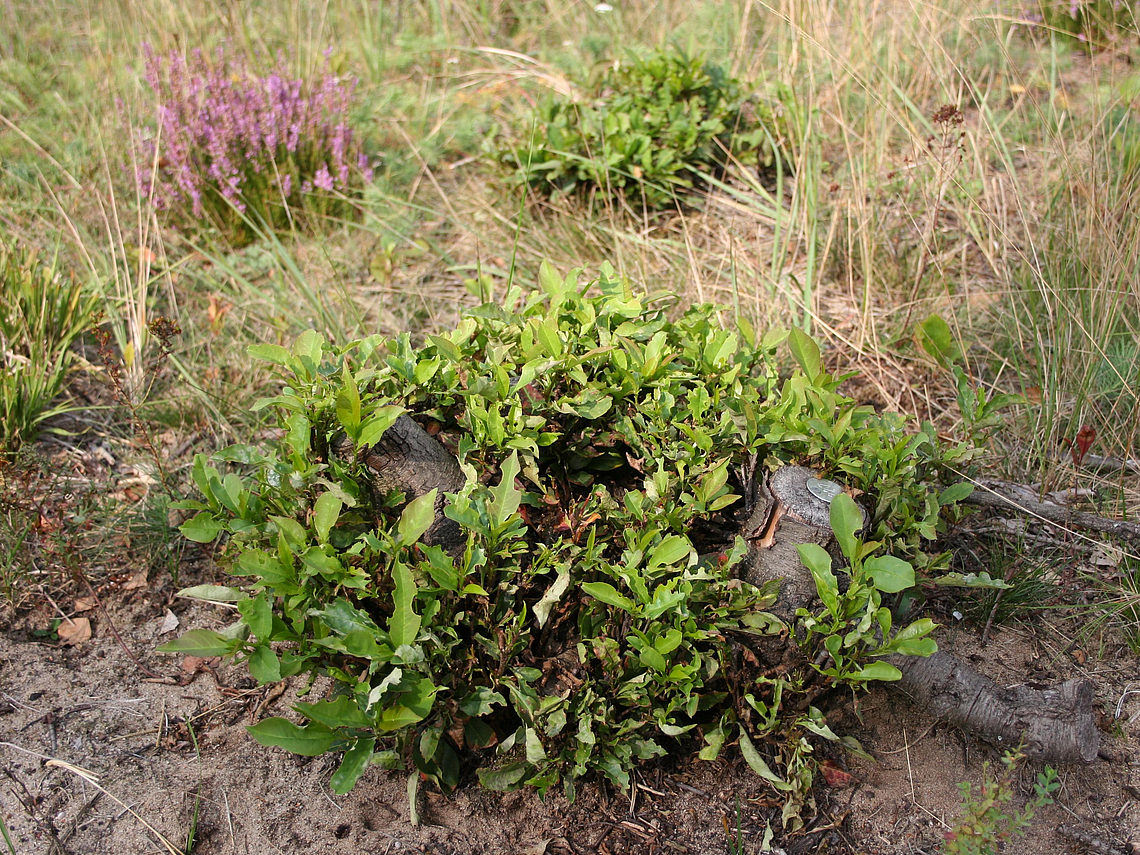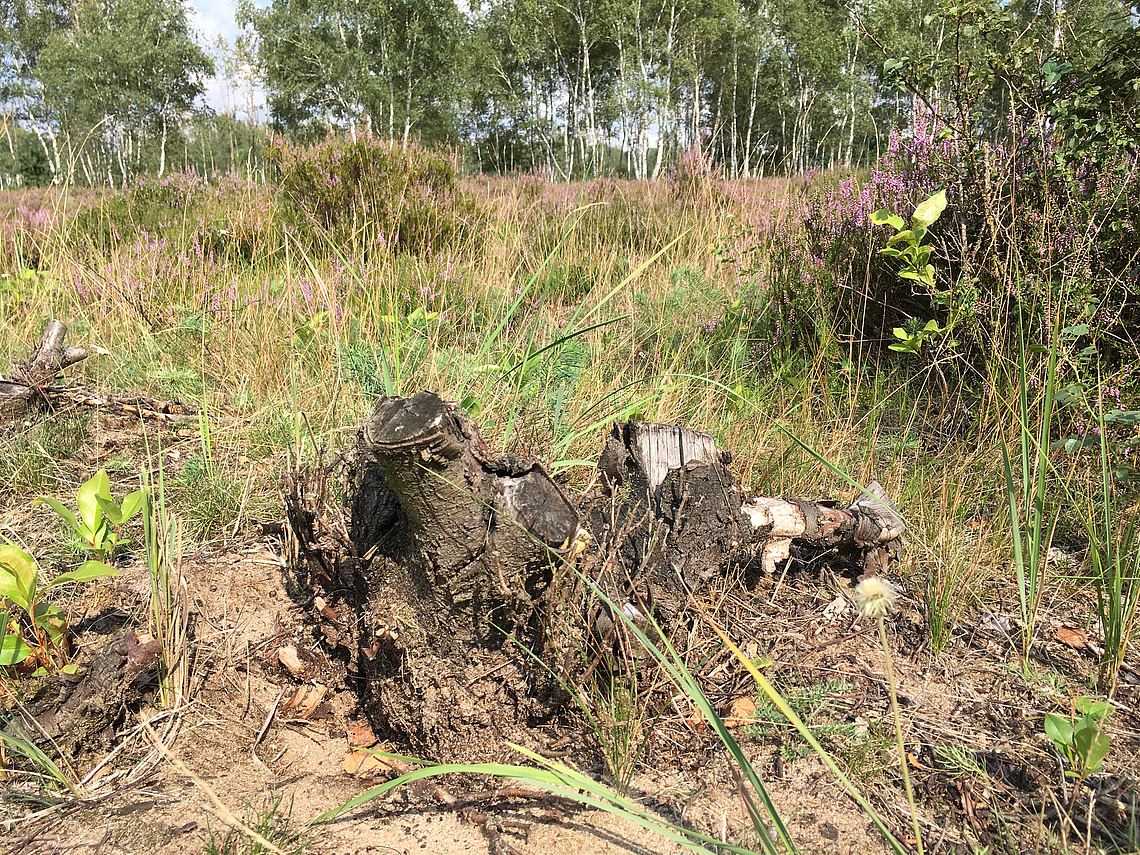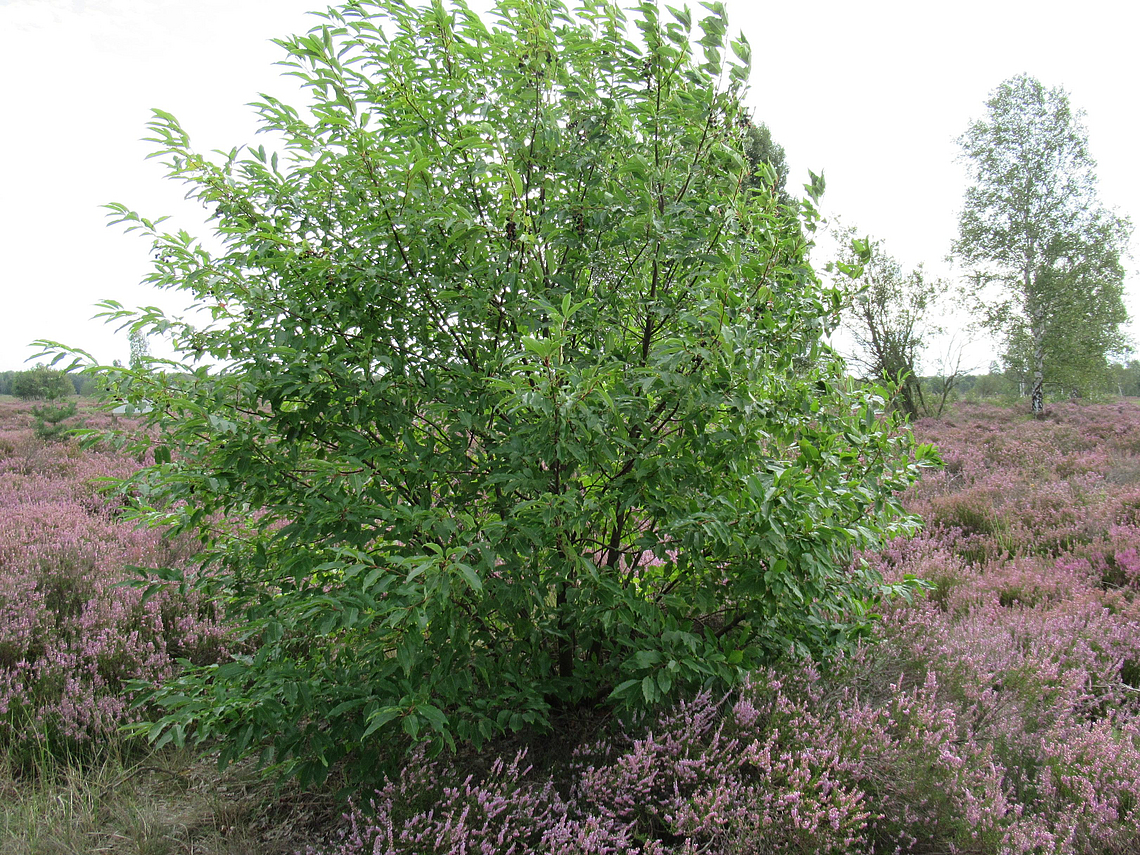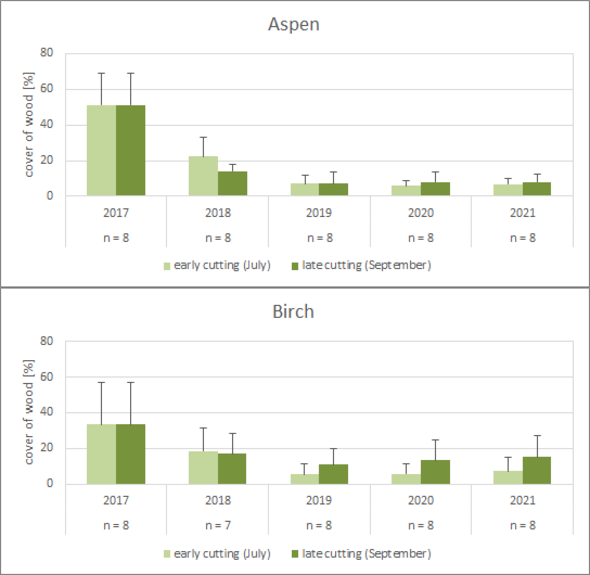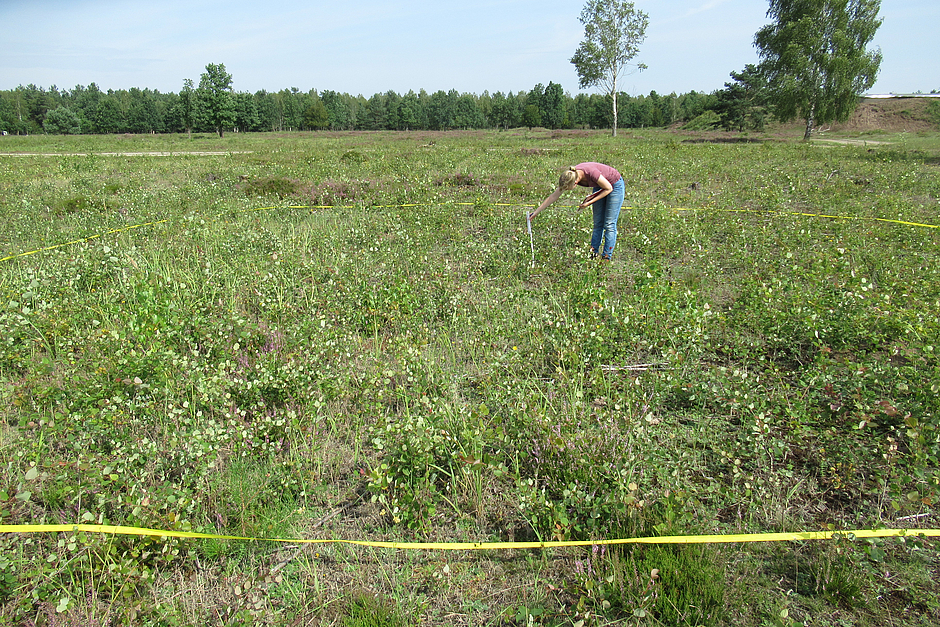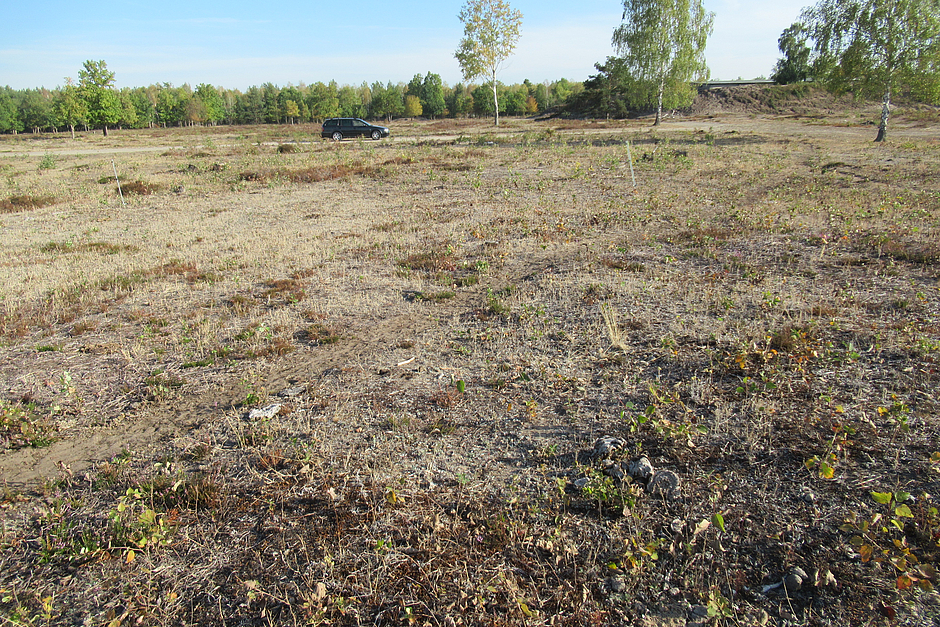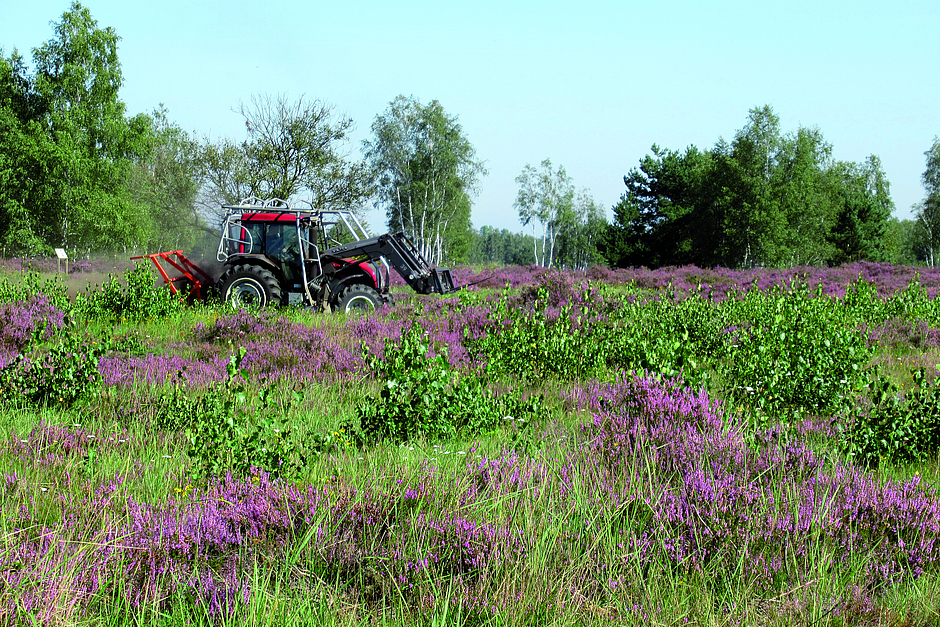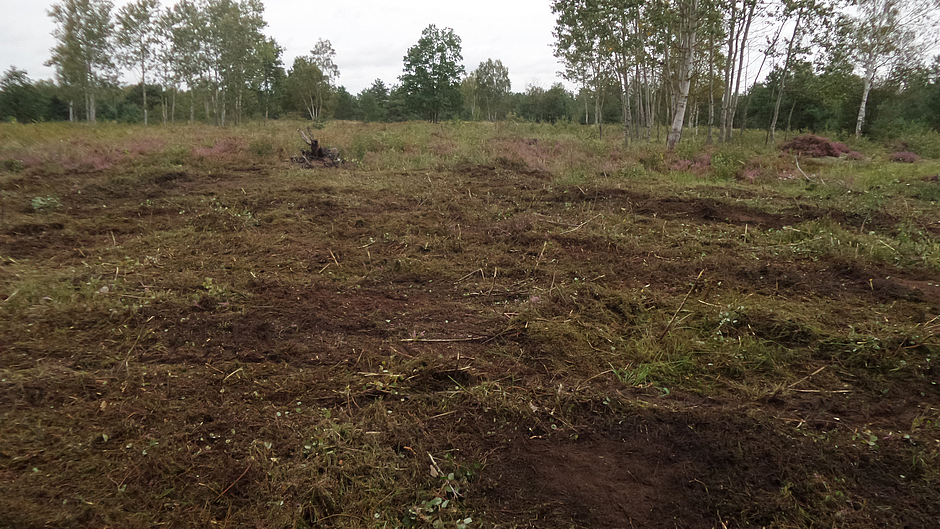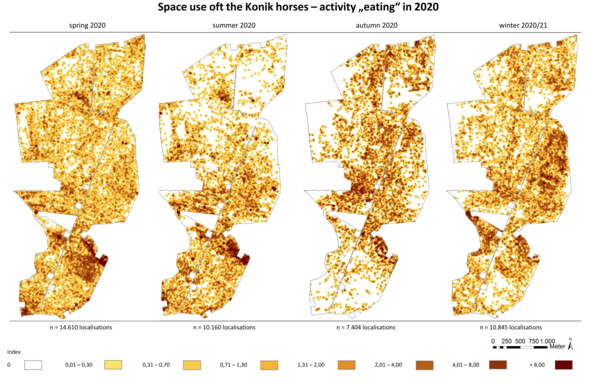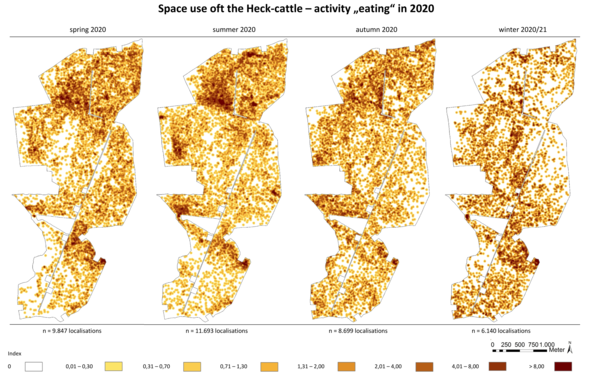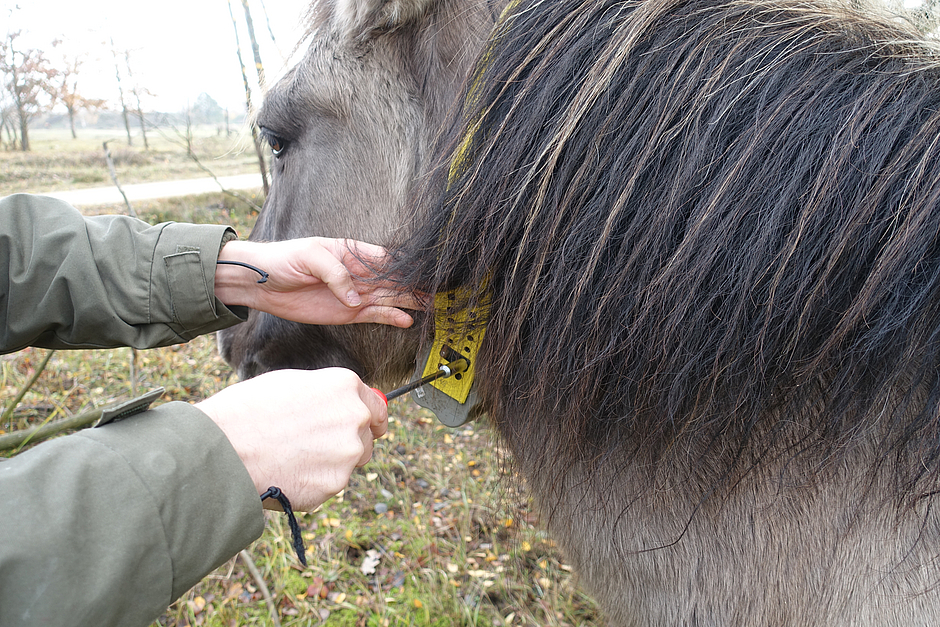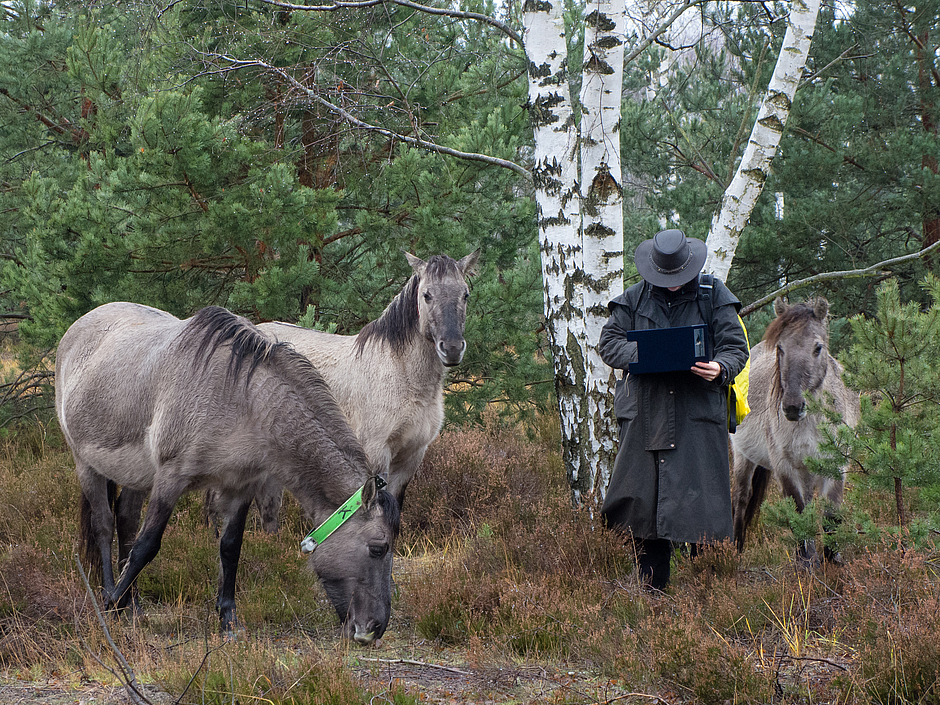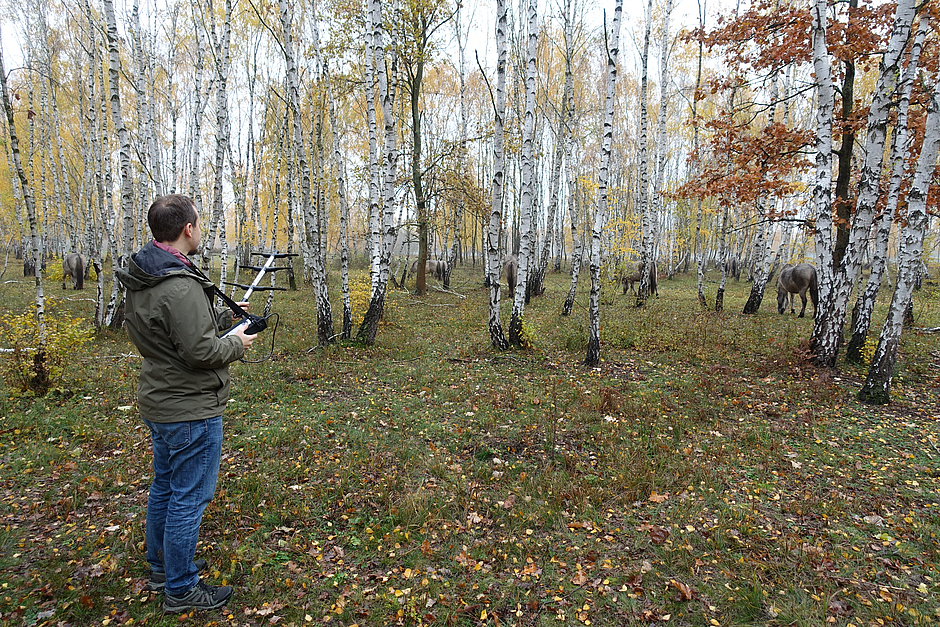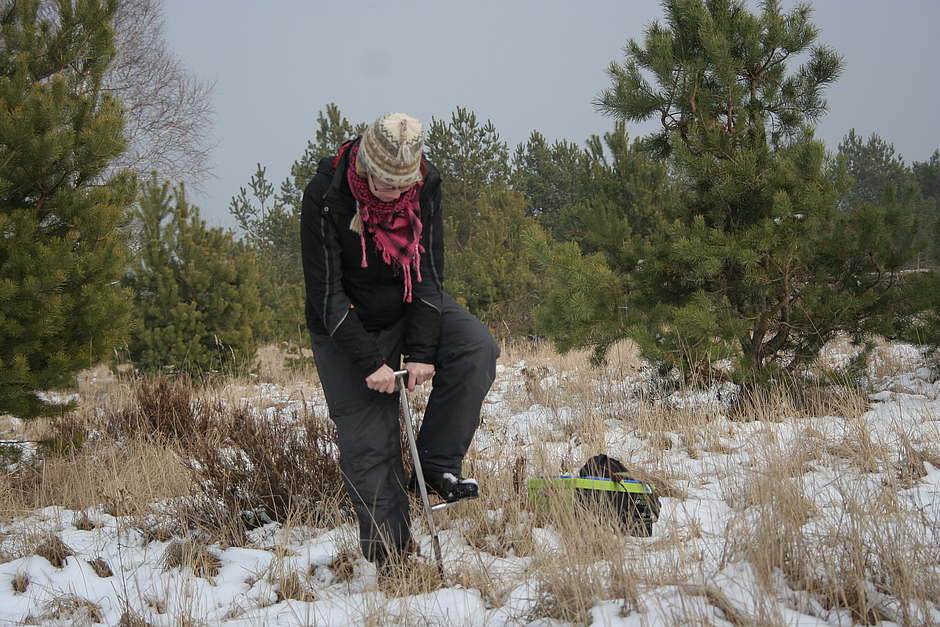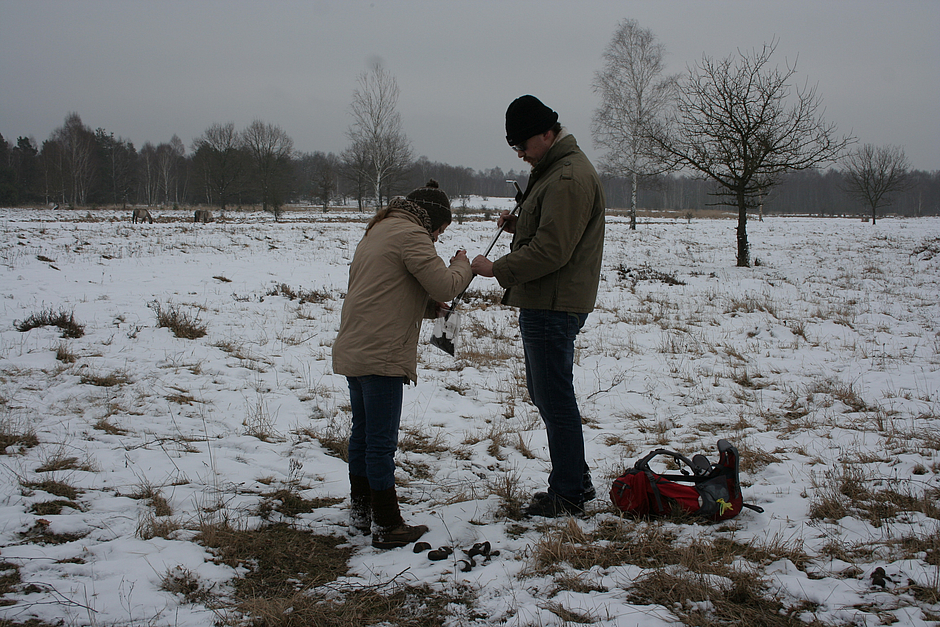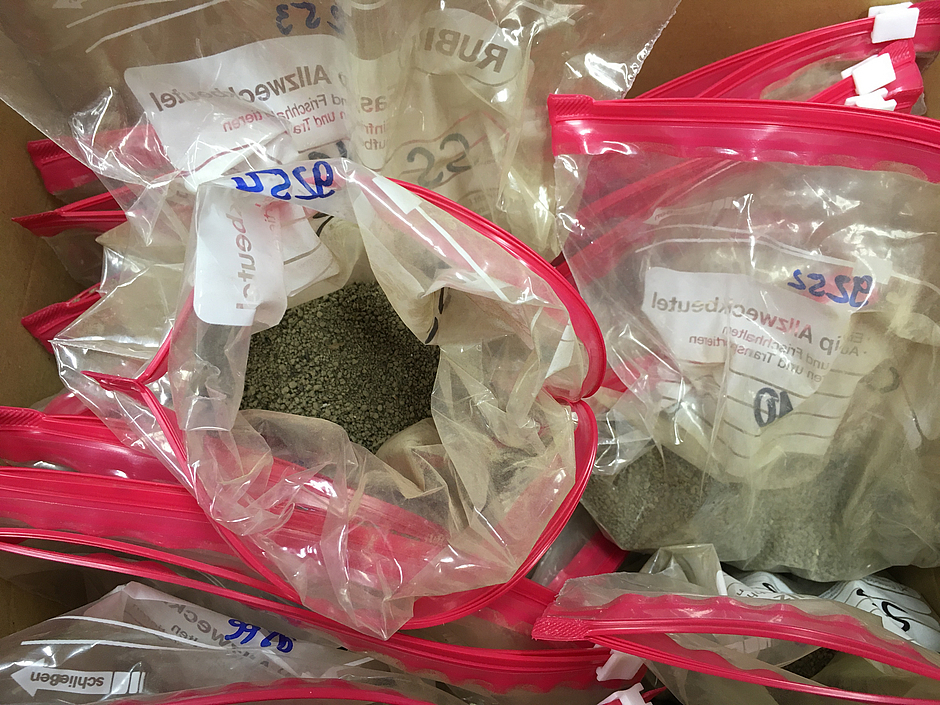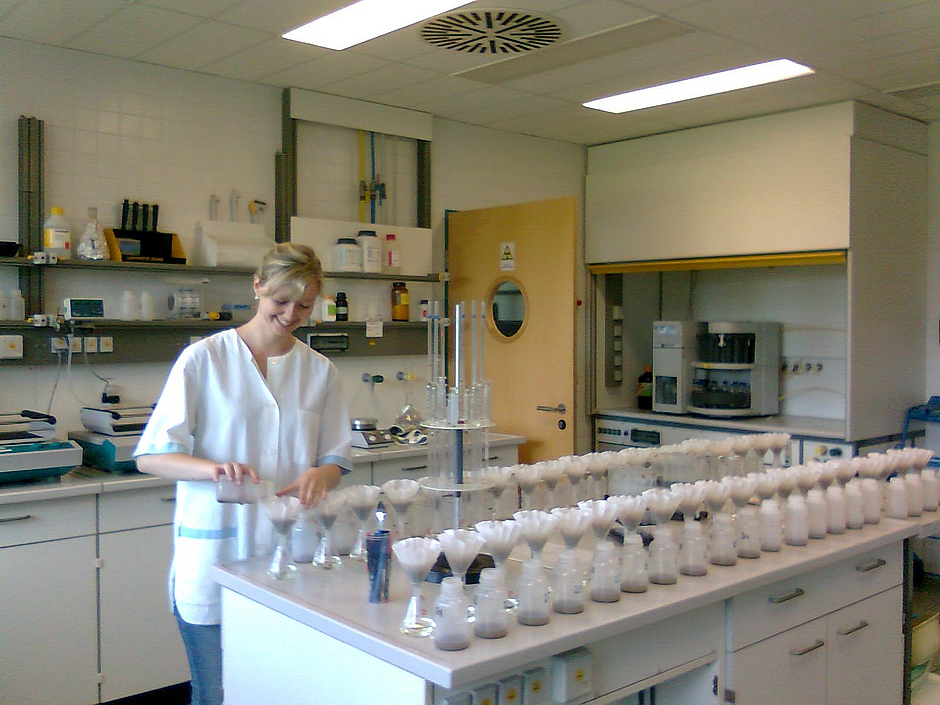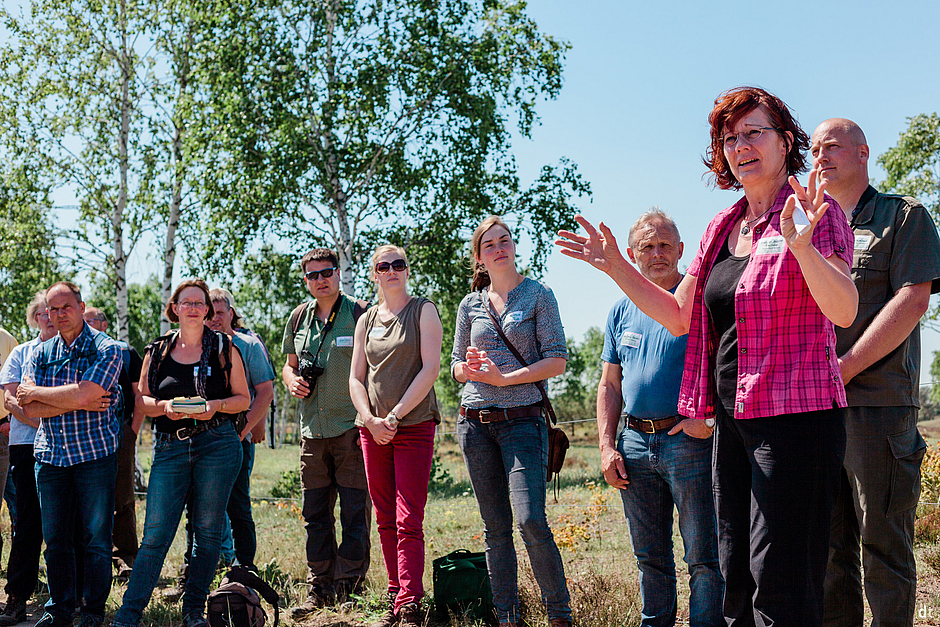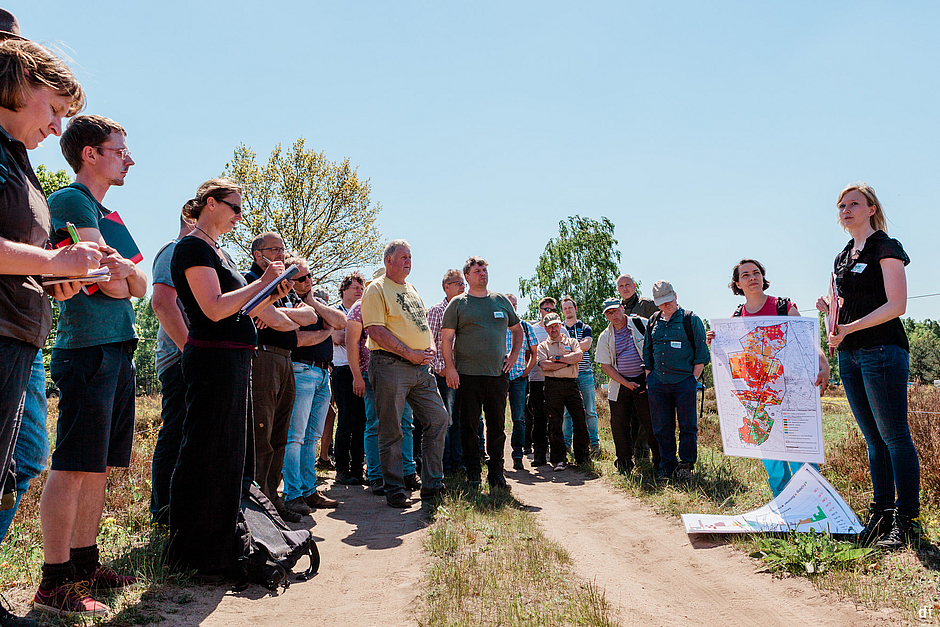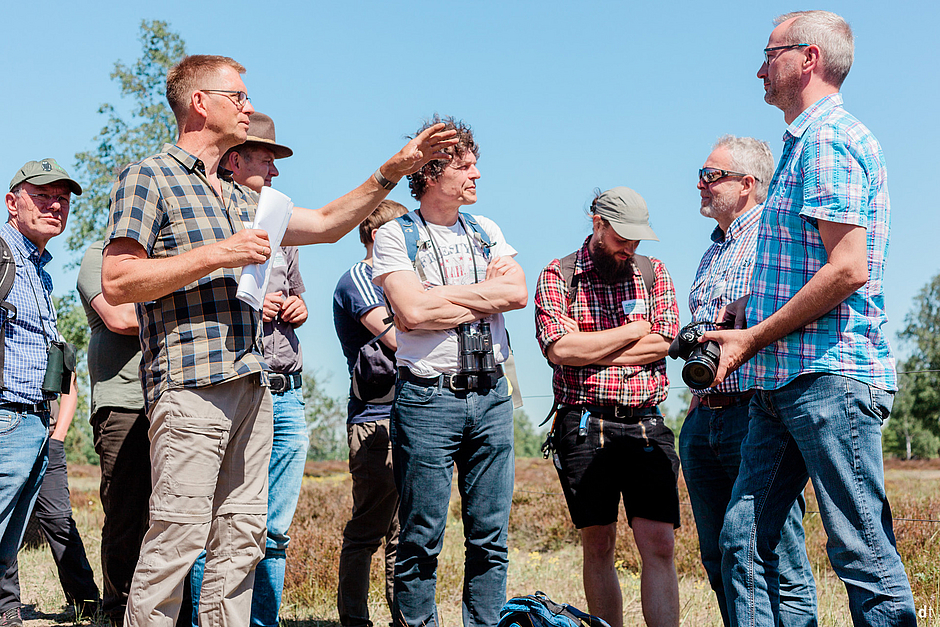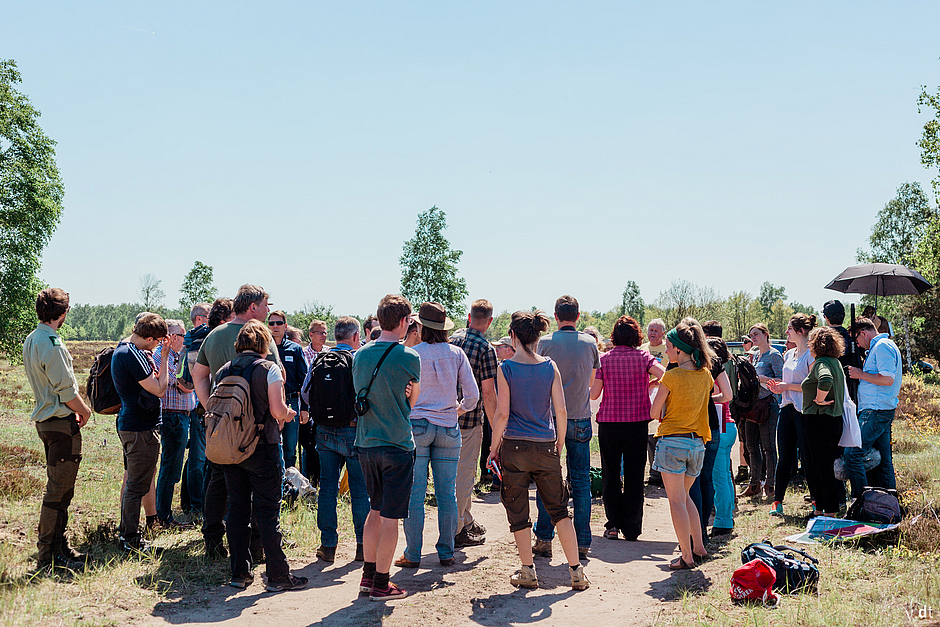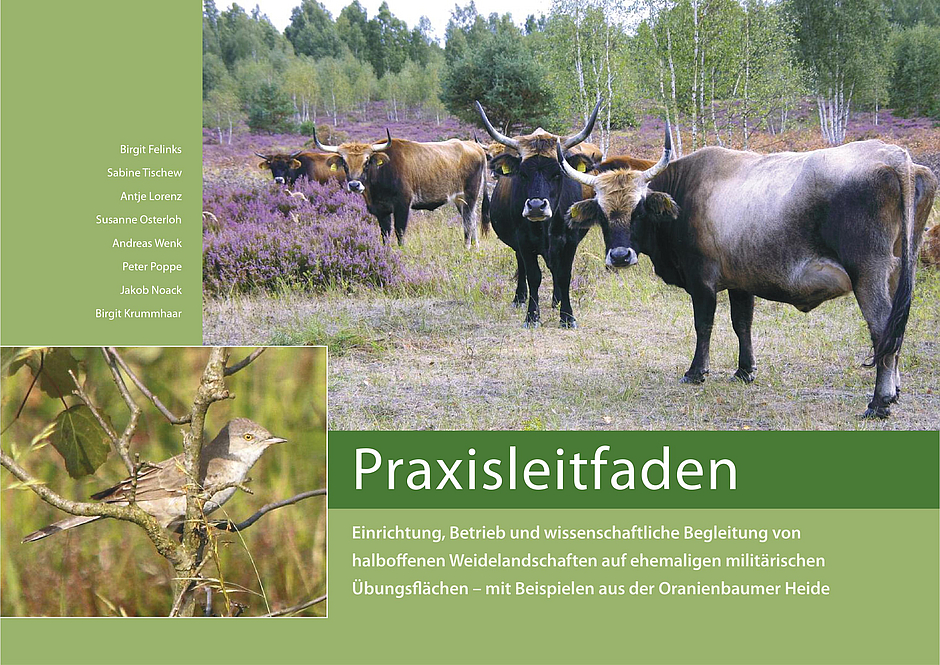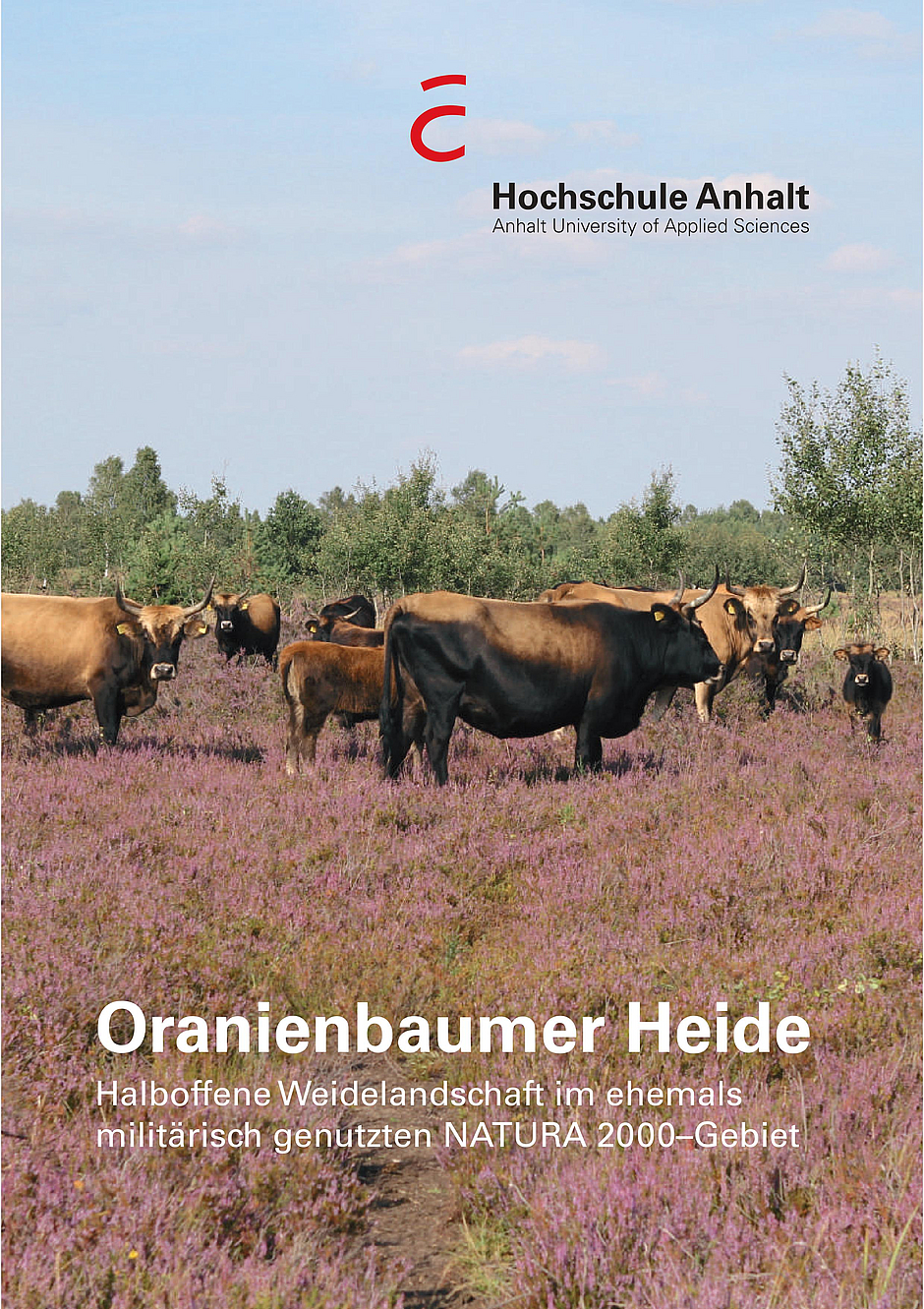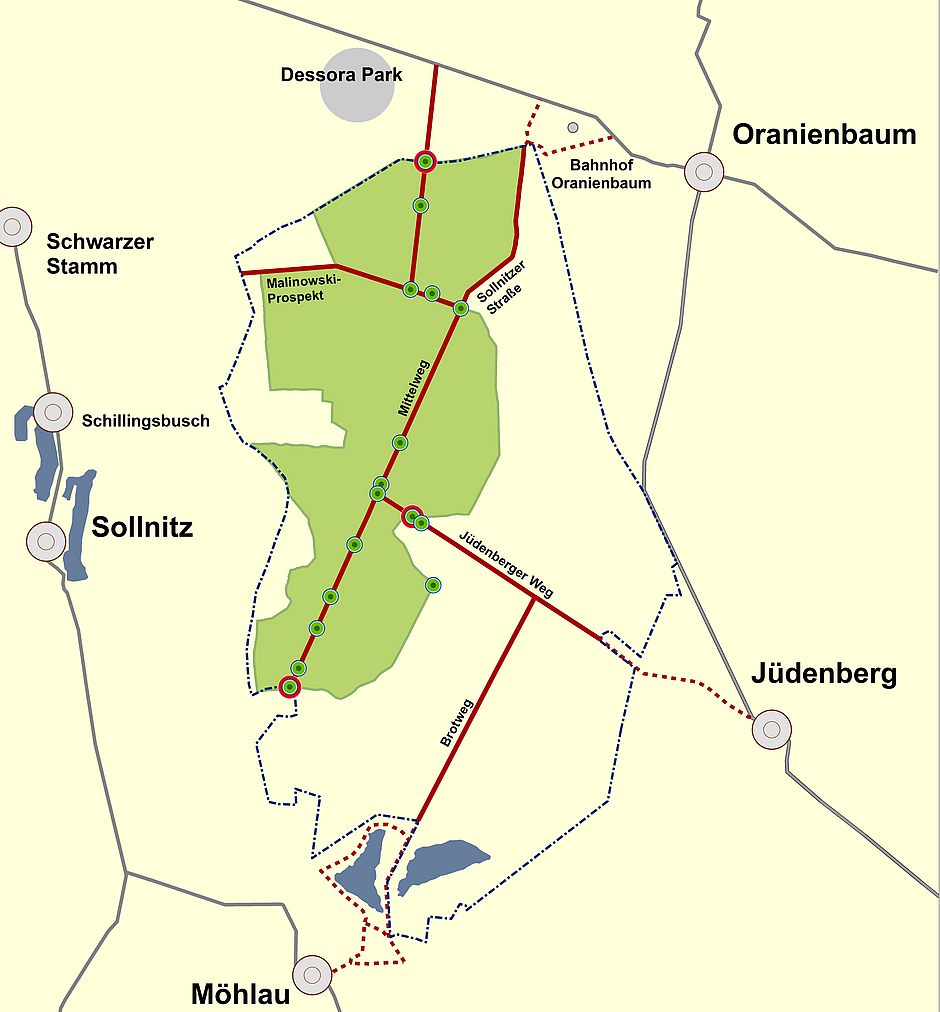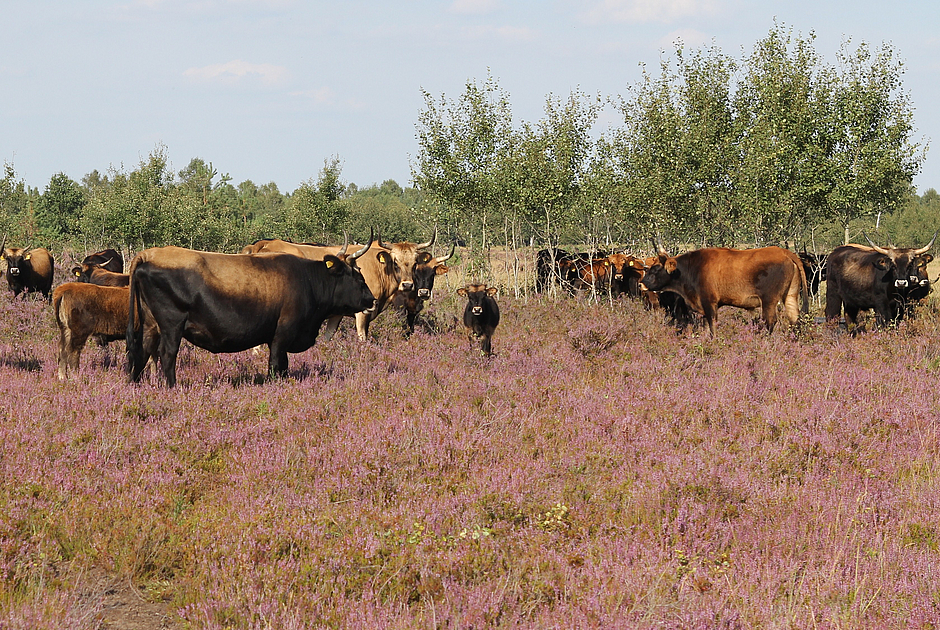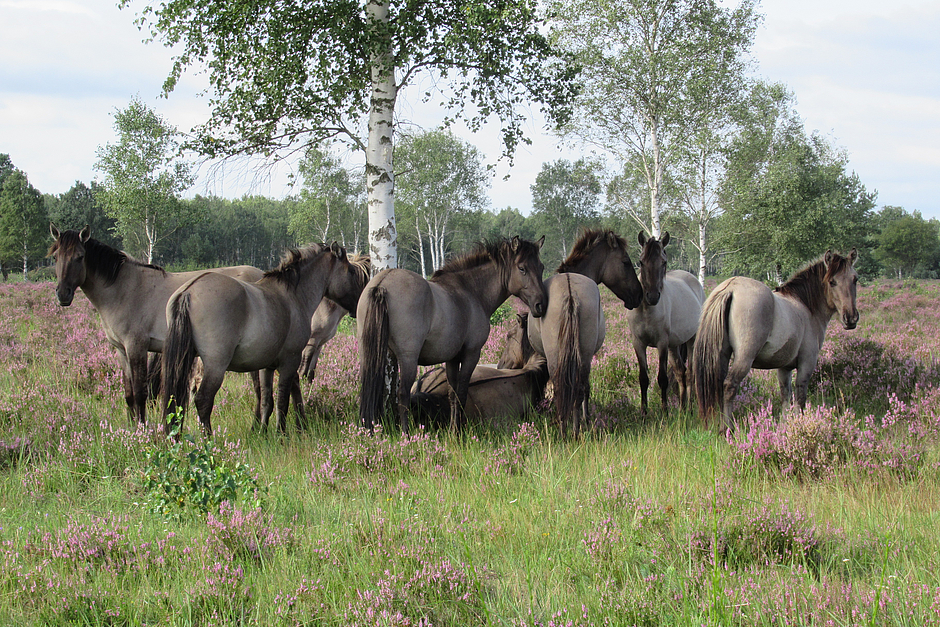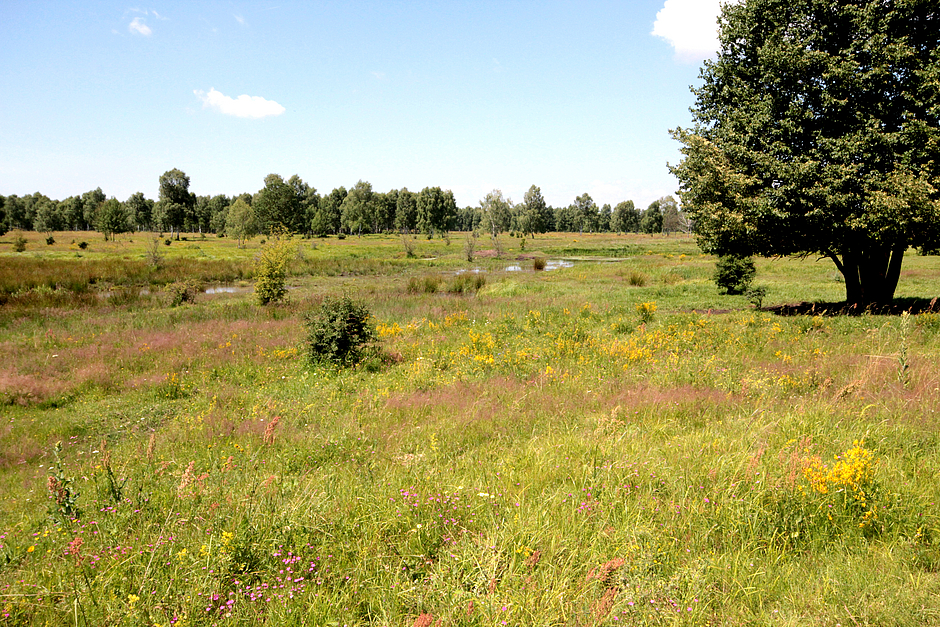The Oranienbaumer Heide
The Oranienbaumer Heide
The NATURA 2000 site Oranienbaumer Heide is located in the Eastern part of Saxony-Anhalt, Germany. From 1945 until 1989, the site was used for military training activities by Soviet troops, thus maintaining a large-scale open landscape, nutrient-poor soil conditions and species richness through a combination of heterogeneously distributed disturbances from military training activities and the exclusion of intensive agriculture or forestry.
Political changes have led to the cessation of military use for nearly 2 decades, from 1989 to 2008. As a consequence of the abandonment of military training activities, woody species, mainly Scots pine (Pinus sylvestris) and silver birch (Betula pendula) encroached rapidly. In addition, the spread of competitive grasses such as bushgrass (Calamagrostis epigejos), accompanied by a high litter accumulation, the predominance of degenerate Calluna vulgaris stands - the key species of dry heaths - as well as the lack of bare soil patches, are main degradation processes. Moreover, the invasive alien tree species black cherry (Prunus serotina) occured in some parts of the area.
Habitats of community interest, such as “European dry heaths” (referred to as dry heaths; habitat code 4030), “Xeric sand calcareous grasslands” (referred to as dry sandy grasslands; habitat code 6120*) as well as mosaics of these habitat types (habitat code 4030/6120*) and inland dune habitats (habitat code 2310 and 2330) are in the focus of current nature conservation activities. Today, the Oranienbaumer Heide is one of the most habitat and species rich areas in Saxony-Anhalt. However, at the beginning of the restoration process, the conservation status of habitat types of community interest were listed as unfavourable-bad.

Heathland, © Catherin Nolte 
Base-rich sand lawn, © Sabine Tischew 
Habitat mosaic made of heather and base-rich sand lawns, © Susanne Osterloh Project goals
Project goals
The project is pursuing an important goal set out in the biodiversity strategy of the federal state of Saxony-Anhalt, according to which utilisation or maintanance concepts for heathlands and dry grasslands are to be developed and implemented.
Results from previous projects (Project Archive) demonstrate the great success of the restoration and management measures for the habitat types of community interest and their species communities that occurring in the Oranienbaumer Heide. Nevertheless, to improve the conservation status of the habitat types, additional management measures has to be develeoped and implemented. Moreover, the coordinative and scientific monitoring of all measures is urgently needed. The Anhalt University of Applied Sciences is responsible for the coordination of the entire project. In addition, all management measures are designed as well as continuously evaluated and scientifically monitored by the Anhalt University of Applied Sciences.
The current work focusses on:
- Large-scale rejuvenation of degenerate heaths with high coverages of grasses or woody species
- Evaluation of the effectiveness of mechanical maintanance measures against the regrowth of birch and poplar
- Development of strategies to reduce the occurence of the black cherry (Prunus serotina)
- Evaluation of all management measures related to the conservation status of the habitat types of community interest and the occurrence of valuable breeding bird species of the open and semi-open landscape
- Collection and analysis of the spatial utilization of the grazing animals by using telemetry data (GPS and activity data)
- Knowledge transfer into the nationwide practice and public relations

European dry heaths, © Susanne Osterloh 
Dry sandy grasslands, © Antje Lorenz 
Mosaics of heaths and dry sandy grasslands, © Catherin Nolte 
Inland dune with Corynephorus canescens, © Thomas Stephan Management
Management
In order to maintain biodiversity, a low-intensity, year-round grazing system with heck cattle and konik horse was established by the Anhalt University of Applied Sciences and the Primigenius gGmbH of the NABU RV Köthen in 2008. Today, cattle and horses graze on approximately 800 ha.
In order to restore the habitat types that were heavily degraded at the beginning of the project, trees and shrubs were extensively cleared on 555 ha in cooperation with the Federal Forestry Company "Mittelelbe". The strength of the shrub and tree clearance was oriented on the one hand to the improvement of the vegetation structure of the habitat types, on the other hand to the habitat requirements of faunistic target species such as e.g. woodlark and nightjar. At the same time, additional management measures were done to promote the rejuvenation of degenerate heather stands (one-time mowing and a one-time mulching) on a total of 80 ha in cooperation with the Federal Forestry Company "Mittelelbe" and the farmer.
The year-round grazing system as well as additional management measures are continuously evaluated by the Anhalt University of Applied Sciences, and optimized together with the farmer. The semi-open pasture landscape Oranienbaumer Heide is one of the largest low-intensity, year-round pastures in Germany and was honored as the pasture landscape of the year in 2017.

Heck cattle in the Oranienbaumer Heide, © Antje Lorenz 
Konik horses and Heck cattle in the Oranienbaumer Heide, © Claudia Meier 
Additional management measure: one-time mowing of degenerate heath,
© Antje Lorenz
Additional management measure: removal of trees and shrubs, © Antje Lorenz Scientific monitoring

Fig. 1: Habitat types of community interest and permanent plots to evaluate management success within the pasture (800 ha). Scientific monitoring
Monitoring is a central component of all restoration and management measures. For this purpose, Anhalt University of Applied Sciences set up a network of more than 160 permanent plots befor implementation of management measures in 2008 (Fig. 1). On these plots, data to the state of habitats and species are collected. For example, the conservation status of habitat types of community interest regarding vegetation structure, impairments and species inventory is evaluated periodically on the 1 ha macroplots.
Indicators for evaluating the management success include, for example, the proportion of ruderal indicators as well as the proportion of characteristic plant species. For example, effects of management measures (shrub an tree clearance, grazing, one-time heather mowing) can be evaluated by comparing the initial state at the beginning of the project with the current state (before / after comparison). In addition, a comparison between grazed and ungrazed (fenced) plots allows the evaluation of the explicit effect of year-round grazing. Moreover, the current state of habitats is evaluated with the nature conservation objectives that are formulated for the area (target/actual- comparison).
Furthermore, two heck cattle and konik horses each are equipped with a GPS collar to study the feeding and space-utilisation behavior of the grazing animals. Collected data as well as evaluations give us information about the development of species and habitats. In case of possible undesirable developments or too slow restoration success, the management will be optimised and, if necessary, corrected.Further investigations
- Studies on the vegetation development at the level of plant species communities (vegetation surveys according to Londo)
- Studies on the occurrence of breeding bird species
- Rejuvenation of heather in a large-scale heath experiment
- Investigations on mechanical pasture care measures to reduce re-sprouting capacity of cut birch and aspen
- Animal observations on the feeding behavior of the grazing animals
- Studies on browsing effects of grazing animals on the invasive black cherry (Prunus serotina)
- Soil analyses for the evaluation of grazing-induced nutrient inputs

Recording of breeding bird species,
© Jana Schonert
Animal observations on the feeding behavior of the grazing animals,
© Catherin Nolte
Heck cattle with GPS collar for studying feeding and space-utilisation behavior, © Katrin Henning 
Performance of vegetation surveys,
© Stefan ReinhardResults of the scientific monitoring
Results of the scientific monitoring
Improvement of the habitat structure
Under the influence of year-round grazing, a more diversely structured vegetation developed over time, caused by the selective feeding preferences of the animal breeds. The proportion of bare soil for in particular the germination and establishment of low-competitive and light-demanding species significatly increased (Fig. 1). Due to the restoration of patchy vegetation structures, a strong spread of light-demanding, low-competitive and at the same time nature conservation valuable species could be observed, such as the ephemeral oatgrass species (Aira caryophyllea, A. praecox) or the farmer's mustard (Teesdalia nudicaulis). These species were particularly able to establish themselves in the newly created stepping stones and animal trails.
In addition, the high accumulated litter layer as well as typical ruderal indicators, such as Calamagrostis epigejos, decreased significantly (Fig. 2). Furthermore, year-round low-inetnsity grazing successfully prevents the further spread of Calamagrostis epigejos within nutrient-poor sandy grassland and heathland communities. Thus, grazed Calamagrostis stands developed towards the target habitat type sandy grasslands.
The rejuvenation process of Calluna vulgaris runs slow. During the first study years, degenerate Calluna stands were largely neglected by the grazing animals due to the high proportion of woody biomass and thus lower fodder quality. Additional management measures, such as mowing, are suitable to facilitate the vegetative rejuvenation of Calluna, whereby the re-growth of young shoots subsequently improves the fodder quality of Calluna and thereby its attractiveness for grazing animals. In areas in which grazing was complemented by a one-time mowing regime, the high proportion of woody biomass was reduced. Consequently, grazing intensity was enhanced after the application of the one-time mowing, resulting in an increase in Calluna rejuvenation.

Comparison between ungrazed (left) and grazed (right) Calamagrotsis stands, © Sabine Tischew 
Creation of bare soil through grazing paths, © Catherin Nolte 
Wallowing konik horses, © Katrin Henning 
Browsing of heather after the one-time mowing management of degenerate heather stands, © Katrin Henning Increase in plant species richness
In all habitat types, the number of target species (characteristic species of the habitat type, Red List species) and other typical species of the heaths, sandy grasslands and sparse fringes increased with the grazing period (Fig. 3).
In the former Calamagrostis-meadows, a serious change in species composition took place: the mean number of species increased from an average of 17 species to 46 species/25 m² after 12 years of grazing (Fig. 3). Former Calamgrostis-meadows developed into sandy dry grasslands, which in many areas can already be assigned to the priority FFH-LRT base-rich sandy grasslands.

Dianthus deltoides, © Thomas Stephan 
Helichrysum arenarium, © Erich Greiner 
Botrychium lunaria, © Erich Greiner 
Peucedanum oreoselinum, © Catherin Nolte 
Fig. 4: Development of the number of breeding pairs of target bird species in the years 2005 to 2020 on the pasture (800 ha).
(Pschorn 2009, Simon & Schonert 2012, Schonert 2017, Schonert 2020)Increase in breeding bird species
Since the beginning of the project, a significant increase of target bird species of the open and semi-open landscape has been identified, such as nightjar, woodlark and stonechat (Fig. 4). Remarkably is the resettlement of hoopoe and wheatear in the study area.
These positive effects result of the management: development (semi-) open structures due to large-scale tree and shrub clearence, creation of a diverse herb layer with bare soil due to grazing, increase in arthropod diversity and quantity due to the drug-free manure of the grazing animals. The result is in a drastic contrast to the downward trend of breeding birds typical of agricultural areas since the 1980s (farmland bird indicator).
Woodlark (Lullula arborea), © Axel Schonert 
Red-backed shrike (Lanius collurio),
© Erich Greiner
Nightjar (Caprimulgus europaeus),
© Martin Jordan
Hoopoe (Upupa epops), © Erich Greiner Large-scale rejuvenation of degenerate heather
In order to improve the conservation status of highly degraded heaths, an experiment with four different treatments was established to rejuvenate heather stands mixed with grasses and poplars in autumn 2017:

Fig. 5: Mechanical rejuvenation of degenerate heath within the pasture. 1. Mowing with the removal of the cutted material
2. Mowing without the removal of the cutted material
3. Mulching (near the surface, no soil injuries)
4. Control (without mechanical treatments)All treatments are subjected to the year-round, low-intensity horse and cattle grazing. Due to the exceptionally dry weather conditions during the subsequent growing season as well as during the spring and summer of 2019, no heather germination has been recorded so far. Due to the lack of germination, up to now it was not possible evaluate the effectiveness of the investigated treatments.
Changes in the vegetation structure, for example the decrease in the coverage of Calluna, were observed for all treatments between 2017 and 2019. Thereby, the reduction of the coverage of about 24% in the control treatment is due to the die back of the heather. Moreover, all treatments showed a reduction in grasses due to the extreme droughts in spring and summer 2018 and 2019. In addition, the strongest increase in bare soil was observed for the treatment "mulching", followed by the treatment mowing with the subsequent removal of the cutted material and the treatmnet mowing without the subsequent removal of the cutted material.
So far, a total of approx. 125 ha of degenerate heath have been mechanically rejuvenated by means of one-time mowing with subsequent removal of the cutted material and one-time mulching (Fig. 5)

Mowing with subsequent removal of the cuttet material, © Catherin Nolte 
Mulching with a tractor that is protected against ammunition,
© Catherin Nolte
Example for a permanent plot,
© Catherin Nolte
Recording of parameters after the setup of the treatments, © Katrin Henning Reduction of the non-native invasive species black cherry
The black cherry (Prunus serotina) is a tree native to North America, but one of the invasive neophytes in Germany. To prevent the further spread of this species by the grazing animals, all fruiting individuals on the pasture as well as on the fenced control plots were cleared before grazing started. Animal observations as well as investigations to the browsing effects of the grazers showed that, in particular, cattle effectively browse the re-shoots of the black cherries. Intensive browsing leads to a decrease in the ability of regeneration as well as to the death of entire individuals (86 % within 12 years, Fig. 6). This mortality rate refers to single occurrences and occurrences in smaller groups (<0.5 ha) of one-time cleared black cherries. Therefor, management successfully reduces and prevents the further spreading of the black cherry and thus, maintained a high species richness on the grazed area.

Fig. 6: Development of the black cherry between 2009 and 2020. In the ungrazed pioneer forests, however, additional management measures must be taken. For this purpose, an experiment to darken cut-off black cherry individuals by means of large-scale tarpaulins (10 m x 10 m) was established. However, it has proved to be unsuccessful. Although, no new shoots could develop directly below the tarpaulins, black cherry individuals in the peripheral areas of the tarpaulins were all the more vigorous and already returned to fructification within 2 years. For the suppression of large-scale black cherry occurrences in pioneer forests, this method is therefore not suitable. Therefore, new strategies are being developed currently in dealing with such stocks .
- Establishment of a shadow wood bar in the transition area between the pasture area and the adjacent pioneer forests
- Establishment of a (possibly temporary) forest pasture with rear cattle after all bird cherry individuals have been decussed close to the ground
- Control of the bird cherries in the areas adjacent to the pasture area through long-term pruning
Please refer to the Practical Guide for more information on the strategies listed above.

Brwosing of the black cherry by heck cattle, © Manuela Krug 
Example of a black cherry on the pasture, © Susanne Osterloh 
Dead black cherry individual on the pasture, © Katrin Henning 
Example of a black cherry on an ungrazed plot, © Katrin Henning Management of woody regrowths
To preserve a good conservation status of the habitat types and the eligibility of the area, the regrowth capacity of birch and aspen has been investigated on permanent plots since autumn 2017. By means of the investigations, suitable aftercare intervals as well as the duration of that shall be determined. Following treatments are examined:
- Mulching (near the surface, no soil injuries), early cutting (July)
- Mulching (near the surface, no soil injuries), late cutting (September)
- Control (without mechanical treatments)

Fig. 7: Development of the coverage of aspen (above) and birch (below) in the variants "early cutting" and "late cutting" between the years 2017 and 2020. Already in the first year after the implementation of the cutting measurements, a strong reduction in the wood coverage (Fig. 7) as well as in the average height of the woody resprouts of birch and aspen was observed. However, the strong reduction also resulted from the extreme drought in 2018 and 2019, with which a reduced growth of the woody plants as well as an increased browsing of the grazing animals is associated. In 2019 there was a decreased reduction of wood cover, especially for birch, in the "late cutting" variant compared to the "early cutting" variant. This trend continued, resulting in an increased birch cover in the "late cutting" variant in 2020 and 2021 compared to the previous year. Overall, the reduction in wood coverage within one year decreased significantly in both variants. However, this development could be related to greater amounts of precipitation in 2020 and 2021.
In order to be able to estimate the probable duration of the post-maintenance work, further investigations are necessary, because woody resprouts only react to mechanical measures over a longer period of time.

Example of a permanent plot before the first mulching, © Antje Lorenz 
Example of a permanent plot one year after the first mulching, © Antje Lorenz 
Mulching of woody regrowths with a tractor that is protected against ammunition, © Antje Lorenz 
Example of a permanent plot immediately after the first mulching,
© Catherin NolteSpace use of the grazing animals
Since 2009, 2 cattle and 2 horses each have been equipped with a GPS collar, which also collect the activity of the grazing animals (eating, resting, running). Data can be used to model the space use and determine the habitat preferences of the grazing animals for the 3 main activities.
The evaluation of the space use of the grazing animals for the year 2020 shows that both animal breeds use the entire grazing area for food intake (activity "eating", Fig. 8 and 9). Seasonal differences in behavior and preferred habitats (shown as a higher index in maps) as well as areas rarely used for food intake were identified.
Since the year 2016 and especially in the drought year 2018, a shift in the use towards the northern parts of the pasture can be seen for the Heck cattle. The eastern part of the middle pasture is less intensively frequented, especially in autumn 2020 and winter 2020/21. Areas that were less frequented by cattle, such as the eastern part of the middle pasture, were more intensively used by the Koniks. Overall, in comparison to the cattle the horses use especially the southern as well as the eastern part of the pasture.

Heck cattle with a GPS collar,
© Katrin Henning
Konik horses with a GPS collar,
© Catherin Nolte
Konik with transmitter collar,
© Catherin Nolte
Reading out the collar data, © Marieke Müller Preservation of nutrient-poor site conditions
One aim of open land management in the Oranienbaumer Heide is to maintain soil conditions that are poor in nutrients. In order to be able to make statements about the long-term development of soil nutrient content and the long-term maintenance of nutrient-poor soil conditions in the grazed project area, mixed soil samples in the topsoil (0-10 cm) were regularly taken and compared at the beginning of grazing in 2009 and in the further course of the project.
As part of the change analysis, it became clear that the soil parameters for all of the considered habitat and biotope types changed only slightly over time. A slight decrease in the pH value could be detected for almost all locations in the area, with the pH value in 2018 on the grazed and non-grazed areas averaging 5.0 and 4.9, respectively. Likewise, only minor changes were found for nitrogen (N) and carbon (C) on grazed and non-grazed areas in the course of the year, also for the areas that are more frequented by grazing animals (fishing station, drinking area): an increase of 0.02% N and 0, 55% C on grazed areas between 2009 and 2018. In addition, overall phosphorus limitation for the heather habitat type can be ruled out, as the total phosphorus content increased slightly between 2013 and 2018 in both grazed and non-grazed heaths.

Taking soil samples, © Susanne Osterloh 
Taking soil samples, © Susanne Osterloh 
Soil samples prepared for analysis, © Katrin Henning 
Analysis of the soil samples in the laboratory, © Sandra Matthes Knowledge transfer & public relations
Knowledge transfer & public relations
If you would like to know more about the Oranienbaumer Heide and the scientific monitoring as well as the conducted management measures, you will find the most important information in our current information flyer (only available in German), which is available for download.
Furthermore, we regularly carry out field trips into the Oranienbaumer Heide, where you can explore and experience the fascinating area, the management successes as well as animal and plant species close up. The next excursion is planned for August 2019. You will find further information on this homepage in due course.
Information about the Oranienbaumer Heide are also published in the regional press. The results of our scientific research will be published in national and international journals (see publications).In addition, as part of the transfer of knowledge into nationwide practice, other farmers in particular shall be motivated to implement low-intensity grazing practices. For this purpose, a workshop was held on May 7, 2018 in the Oranienbaumer Heide on the topic "Conservation and restoration of semi-open habitat types of community interest through large-scale, year-round grazing". About 50 participants, including agricultural holdings, landscape maintenance associations, conservation and farmers' associations, foundations, conservation and agricultural authorities, and companies, learned about the grazing project and exchange views on year-round, low-intensity grazing systems.

Workshop in May 2018, © Anhalt University of Applied Sciences 
Workshop in May 2018, © Anhalt University of Applied Sciences 
Workshop in May 2018, © Anhalt University of Applied Sciences 
Workshop in May 2018, © Anhalt University of Applied Sciences 
Best practice guide. 
Information flyer. Exciting insights into, for example, the history and development of the area, current management practices, habitats and the exceptional fauna and flora can be found on our educational trail. Our best practice guide (as of 2019, only available in German) contains information about the implementation, operation and scientific monitoring of semi-open pasture landscapes in former military training areas.
Access to the semi-open pasture landscape Oranienbaumer Heide
Access to the semi-open pasture landscape Oranienbaumer Heide

Figure 1: Access to the Oranienbaumer Heide (TK 1:10.000 (LVermGeo LSA)
Genehmigungsnr. LVermD 196/P/97).Arrival by car
The heathland "Oranienbaumer Heide" is located between Dessau-Rosslau and Oranienbaum-Wörlitz. Coming from Dessau-Rosslau you can get there following the road B107 heading towards Oranienbaum-Wörlitz. You have to pass the traffic light crossing at the Dessora-Park (industrial area) and follow the B107 for further 400 m. Then you will have to turn right to reach a parking area (without liability), followed by a straight forest path. After parking you car you have to follow the forest path on foot or by bicycle for about 1 km. You will finally arrive at the northern boundary of the grazed open-landscape of the Oranienbaumer Heide (Figure 1: northern access, upper red point). Alternatively you can park your car at the railway station "Bahnhof Oranienbaum" and reach the pasture according to the map at the right.
Access by food or bicycle
Furthermore, the heathland can be reached on food or by bicycle from Jüdenberg or Möhlau following the bikeable walking path Jüdenberger Weg (Figure 1: eastern and southern access, red points).
Publications
Publications
2021
Lorenz, A., Schonert, A., Hensen, H., Henning, K. & Tischew, S. (2021): Der fortschreitende Biodiversitätsverlust ist umkehrbar: Steigerung der Brutvogeldichte in nutzungsabhängigen FFH-Lebensräumen durch großflächiges, naturschutzkonformes Management*. Acta ornithoecologica, 9 (3), 233-246.
Lorenz, A., Schonert, A., Henning, K. & Tischew, S. (2021): Der fortschreitende Biodiversitätsverlust ist umkehrbar: Steigerung der Artenvielfalt in nutzungsabhängigen FFH-Lebensräumen durch großflächiges, naturschutzkonformes Management. Natur und Landschaft, 96 (2), 74-82. DOI: 10.17433/2.2021.50153879.74-82
Tischew, S., Henning, K. & Lorenz, A. (2021): Naturschutzfachliche Erfolgskontrolle und adaptives Management großflächiger Beweidungsverfahren am Beispiel der Oranienbaumer Heide. Naturschutz und Biologische Vielfalt 171: 273-292.
2019
Lorenz, A., Henning, K., Tischew, S., Felinks, B. et al. (2019): Praxisleitfaden: Einrichtung, Betrieb und wissenschaftliche Begleitung von halboffenen Weidelandschaften auf ehemaligen militärischen Übungsflächen – mit Beispielen aus der Oranienbaumer Heide. Hochschule Anhalt, Bernburg. 60 S. [pdf]
Lorenz, A. & Tischew, S. (2015): Zwergstrauchheiden. In: M. Bunzel-Drüke, C. Böhm, G. Ellwanger, P. Finck, H. Grell, L. Hauswirth, A. Herrmann, E. Jedicke, R. Joest, G. Kämmer, M. Köhler, D. Kolligs, R. Krawczynski, A. Lorenz, R. Luick, S. Mann, H. Nickel, U. Raths, E. Reisinger, U. Riecken, H. Rößling, R. Sollmann, A. Ssymank, K. Thomsen, S. Tischew, H. Vierhaus, H.-G. Wagner & O. Zimball: Naturnahe Beweidung und NATURA 2000. Ganzjahresbeweidung im Management von Lebensraumtypen und Arten im europäischen Schutzgebietssystem NATURA 2000. Heinz Sielmann Stiftung, Duderstadt. Gefördert durch: Thüringer Ministerium für Umwelt, Energie und Naturschutz (TMUEN), Bayerischer Naturschutzfonds, Stiftung Naturschutz Schleswig-Holstein, 2. überarbeitete und erweiterete Auflage, 90-98.
Lorenz, A. & Tischew, S. (2015): Trockene, kalkreiche Sandrasen. In: M. Bunzel-Drüke, C. Böhm, G. Ellwanger, P. Finck, H. Grell, L. Hauswirth, A. Herrmann, E. Jedicke, R. Joest, G. Kämmer, M. Köhler, D. Kolligs, R. Krawczynski, A. Lorenz, R. Luick, S. Mann, H. Nickel, U. Raths, E. Reisinger, U. Riecken, H. Rößling, R. Sollmann, A. Ssymank, K. Thomsen, S. Tischew, H. Vierhaus, H.-G. Wagner & O. Zimball: Naturnahe Beweidung und NATURA 2000. Ganzjahresbeweidung im Management von Lebensraumtypen und Arten im europäischen Schutzgebietssystem NATURA 2000. Heinz Sielmann Stiftung, Duderstadt. Gefördert durch: Thüringer Ministerium für Umwelt, Energie und Naturschutz (TMUEN), Bayerischer Naturschutzfonds, Stiftung Naturschutz Schleswig-Holstein, 2. überarbeitete und erweiterete Auflage, 104-110.
Lorenz, A. & Tischew, S. (2015): Binnendünen. In: M. Bunzel-Drüke, C. Böhm, G. Ellwanger, P. Finck, H. Grell, L. Hauswirth, A. Herrmann, E. Jedicke, R. Joest, G. Kämmer, M. Köhler, D. Kolligs, R. Krawczynski, A. Lorenz, R. Luick, S. Mann, H. Nickel, U. Raths, E. Reisinger, U. Riecken, H. Rößling, R. Sollmann, A. Ssymank, K. Thomsen, S. Tischew, H. Vierhaus, H.-G. Wagner & O. Zimball: Naturnahe Beweidung und NATURA 2000. Ganzjahresbeweidung im Management von Lebensraumtypen und Arten im europäischen Schutzgebietssystem NATURA 2000. Heinz Sielmann Stiftung, Duderstadt. Gefördert durch: Thüringer Ministerium für Umwelt, Energie und Naturschutz (TMUEN), Bayerischer Naturschutzfonds, Stiftung Naturschutz Schleswig-Holstein, 2. überarbeitete und erweiterete Auflage, 77-81.
Tischew, S., Henning, K. & Lorenz, A. (im Druck): Naturschutzfachliche Erfolgskontrolle und adaptives Management großflächiger Beweidungsverfahren am Beispiel der Oranienbaumer Heide. Naturschutz und Biologische Vielfalt.
2017
Henning, K., Lorenz, A., von Oheimb, G., Härdtle, W. & Tischew, S. (2017): Year-round cattle and horse grazing supports the restoration of abandoned, dry sandy grassland and heathland communities by supressing Calamagrostis epigejos and enhancing species richness. Journal for Nature Conservation, 40, 120-130.
Henning, K., von Oheimb, G., Härdtle, W., Fichtner, A., & Tischew, S. (2017): The reproductive potential and importance of key management aspects for successful Calluna vulgaris rejuvenation on abandoned Continental heaths. Ecology and Evolution, 2017, 1-10. [pdf]
Lorenz, A., Bauschmann, G. & Reinhard, S. (2017): Oranienbaumer Heide ist Weidelandschaft des Jahres 2017. Naturschutz und Landschaftsplanung, 49, 302-303. [pdf]
2016
Lorenz, A., Seifert, R., Osteloh, S. & TISCHEW, S. (2016): Renaturierung großflächiger subkontinentaler Sand-Ökosysteme: Was kann extensive Beweidung mit Megaherbivoren leisten? Natur und Landschaft, 91, 73-82. [pdf]
2015
Henning, K., von Oheimb, G. & Tischew, S. (2015): What restricts generative rejuvenation of Calluna vulgaris in continental, dry heathland ecosystems: seed production, germination ability or safe site conditions? Ecological Questions, 21, 25-28. [pdf]
Lorenz, A. & Tischew, S. (2015): Zwergstrauchheiden. In: M. Bunzel-Drüke, C. Böhm, G. Ellwanger, P. Finck, H. Grell, L. Hauswirth, A. Herrmann, E. Jedicke, R. Joest, G. Kämmer, M. Köhler, D. Kolligs, R. Krawczynski, A. Lorenz, R. Luick, S. Mann, H. Nickel, U. Raths, E. Reisinger, U. Riecken, H. Rößling, R. Sollmann, A. Ssymank, K. Thomsen, S. Tischew, H. Vierhaus, H.-G. Wagner & O. Zimball: Naturnahe Beweidung und NATURA 2000. Ganzjahresbeweidung im Management von Lebensraumtypen und Arten im europäischen Schutzgebietssystem NATURA 2000. Heinz Sielmann Stiftung, Duderstadt. Gefördert durch: Thüringer Ministerium für Umwelt, Energie und Naturschutz (TMUEN), Bayerischer Naturschutzfonds, Stiftung Naturschutz Schleswig-Holstein, 74-79.
Lorenz, A. & Tischew, S. (2015): Trockene, kalkreiche Sandrasen. In: M. Bunzel-Drüke, C. Böhm, G. Ellwanger, P. Finck, H. Grell, L. Hauswirth, A. Herrmann, E. Jedicke, R. Joest, G. Kämmer, M. Köhler, D. Kolligs, R. Krawczynski, A. Lorenz, R. Luick, S. Mann, H. Nickel, U. Raths, E. Reisinger, U. Riecken, H. Rößling, R. Sollmann, A. Ssymank, K. Thomsen, S. Tischew, H. Vierhaus, H.-G. Wagner & O. Zimball: Naturnahe Beweidung und NATURA 2000. Ganzjahresbeweidung im Management von Lebensraumtypen und Arten im europäischen Schutzgebietssystem NATURA 2000. Heinz Sielmann Stiftung, Duderstadt. Gefördert durch: Thüringer Ministerium für Umwelt, Energie und Naturschutz (TMUEN), Bayerischer Naturschutzfonds, Stiftung Naturschutz Schleswig-Holstein, 86-92.
Lorenz, A. & Tischew, S. (2015): Binnendünen. In: M. Bunzel-Drüke, C. Böhm, G. Ellwanger, P. Finck, H. Grell, L. Hauswirth, A. Herrmann, E. Jedicke, R. Joest, G. Kämmer, M. Köhler, D. Kolligs, R. Krawczynski, A. Lorenz, R. Luick, S. Mann, H. Nickel, U. Raths, E. Reisinger, U. Riecken, H. Rößling, R. Sollmann, A. Ssymank, K. Thomsen, S. Tischew, H. Vierhaus, H.-G. Wagner & O. Zimball: Naturnahe Beweidung und NATURA 2000. Ganzjahresbeweidung im Management von Lebensraumtypen und Arten im europäischen Schutzgebietssystem NATURA 2000. Heinz Sielmann Stiftung, Duderstadt. Gefördert durch: Thüringer Ministerium für Umwelt, Energie und Naturschutz (TMUEN), Bayerischer Naturschutzfonds, Stiftung Naturschutz Schleswig-Holstein, 61-65.
Seifert, R.,Lorenz, A., Osterloh, S., Henning, K. & Tischew, S. (2015): Free-range grazing by large herbivores in degraded large-scale dry sandy grassland-heathland ecosystems. Ecological Questions, 21, 87-89. [pdf]
2014
Schonert, A. & Simon, B. (2014): Naturschutzfachliche Erfolgskontrolle von Managementmaßnahmen zum Erhalt und zur Entwicklung von FFH-Offenlandlebensraumtypen im NATURA 2000-Gebiet Mittlere Oranienbaumer Heide – Brutvögel. Berichte des Landesamtes für Umweltschutz Sachsen-Anhalt, 1, 39-48. [pdf]
2013
Felinks, B., Tischew, S., Lorenz,Z A., Osterloh, S., Wenk, A., Poppe, P., Noack, J. & Krummhaar, B. (2013): Praxisleitfaden: Einrichtung, Betrieb und wissenschaftliche Begleitung von halboffenen Weidelandschaften auf ehemaligen militärischen Übungsflächen - mit Beispielen aus der Oranienbaumer Heide. Der Druck dieses Leitfadens wurde gefördert durch die Deutsche Bundesstiftung Umwelt. 49 Seiten.
Lorenz, A., Tischew, S., Osterloh, S. & Felinks, B. (2013): Konzept für maßnahmenbegleitende, naturschutzfachliche Erfolgskontrollen in großen Projektgebieten am Beispiel des Managements von FFH-Lebensraumtypen in der Oranienbaumer Heide. Naturschutz und Landschaftsplanung, 45, 365-372. [pdf]
2012
Felinks, B., Tischew, S., Lorenz, A., Osterloh, S., Krummhaar, B., Wenk, A., Poppe, P. & Noack, J. (2012): Management von FFH-Offenlandlebensraumtypen auf ehemaligen Truppenübungsplätzen. Etablierung einer extensiven Ganzjahresstandweide in der Oranienbaumer Heide. Naturschutz und Landschaftsplanung 44 (1): 14-23. [pdf]
2010
John, H., Lorenz, A. & Osterloh, S. (2010): Die Farn- und Blütenpflanzen des ehemaligen Truppenübungsplatzes Oranienbaumer Heide. Florist. Mitt. Sachs.-Anh.,15, 17-54. [pdf]
Lorenz, A., Osterloh, S., Felinks, B. & Tischew, S. (2010): Extensive Beweidung zum Erhalt und zur Entwicklung von FFH-Offenlandlebensräumen auf ehemaligen Truppenübungsplätzen. In: Vössing A. (Hrsg.) Nationalpark-Jahrbuch der Nationalparkstiftung Unteres Odertal, 7, 68-76. [pdf]
Download area
Download area
Flyer (as of 2018, only available in German)
Poster (as of 2018, only available in German)
Best practice guide (as of 2019, only available in German)Archive
Archive
Futher information about the semi-open pasture landscape "Oranienbaumer Heide" from previous projects ca be found here.
Previous projects:
- supported by the German Federal Environmental Foundation (duration 05/2008-04/2011)
- supported by the European Agricultural Fund for Rural Development Sachsen-Anhalt (duration 05/2011-09/2013 and 10/2013-10/2015)

Heck cattle in one-time mown heaths. © Sabine Tischew 
Mosaics of heaths and dry sandy grasslands. © Catherin Nolte 
Konik horses in haths. © Antje Lorenz 
Colourfull mosaic in the Oranienbaumer Heide. © Sabine Tischew Contact details
Project leader: Prof. Dr. Sabine Tischew
Researchers: Heiner Hensen (M. Sc.), Mark Pfau (M. Sc.), Marieke Müller (M. Sc.)
Project duration: 02/2017 - 09/2021 (FKZ: 407.1.7.60128/630116000007)
Funded by: ELER Sachsen-Anhalt, funding period 2014-2020
Europa-ELER, ELER-Sachsen-Anhalt, Landesverwaltungsamt Sachsen-Anhalt
Supported by: Landesamt für Vermessung und Geoinformation Sachsen-Anhalt
Site owner: DBU Naturerbe GmbH
Project partners: Primigenius – Köthener Naturschutz und Landschaftspflege gGmbH,
Cooperation partners: Biosphärenreservat "Mittelelbe", Bundesanstalt für Immobilienaufgaben, NABU RV Köthen
